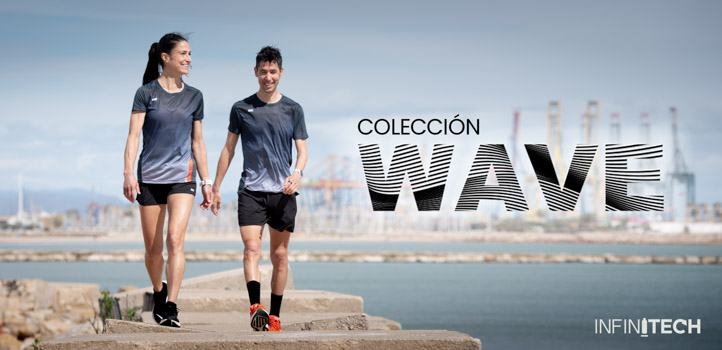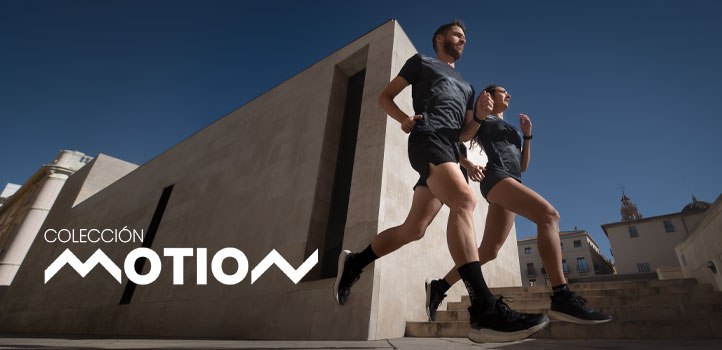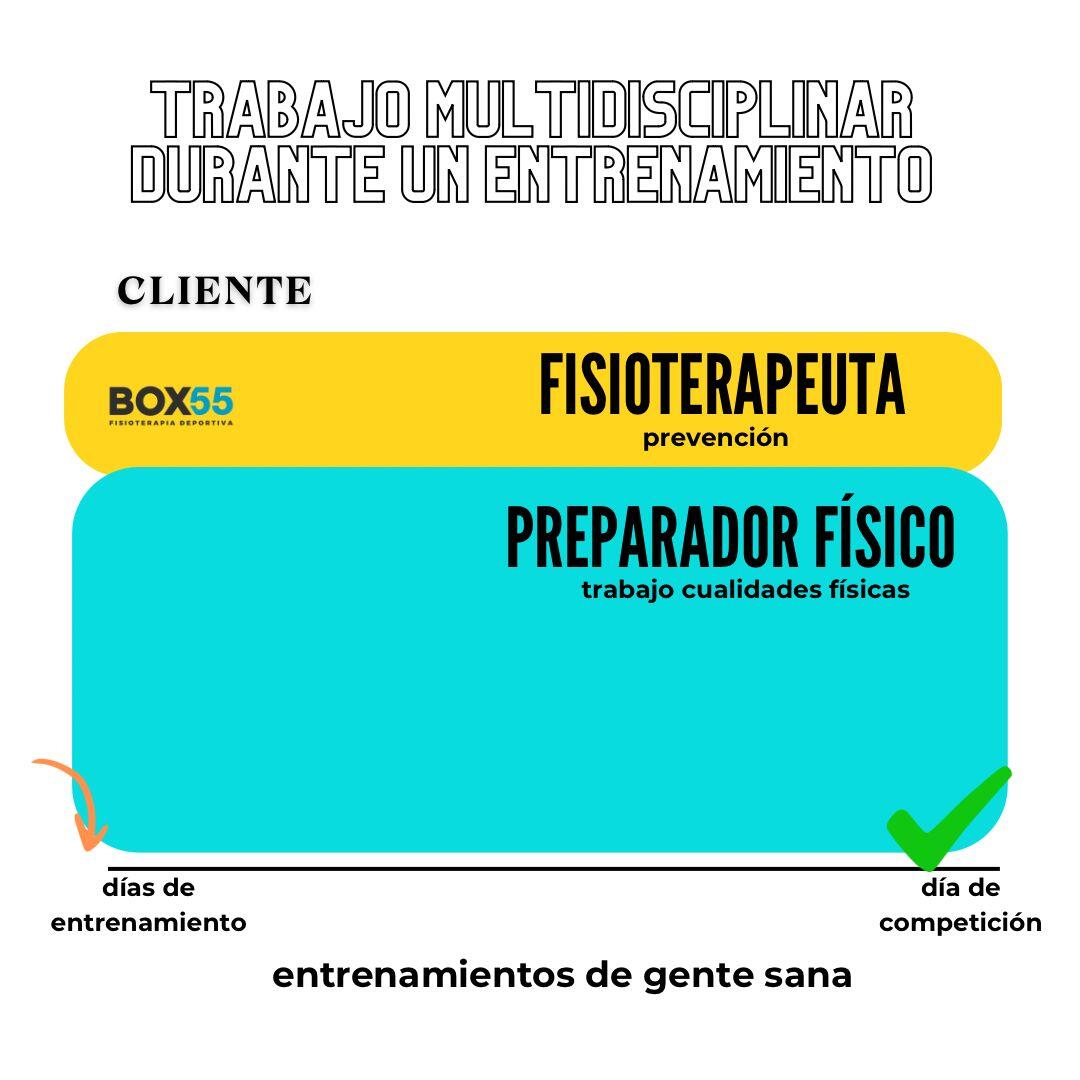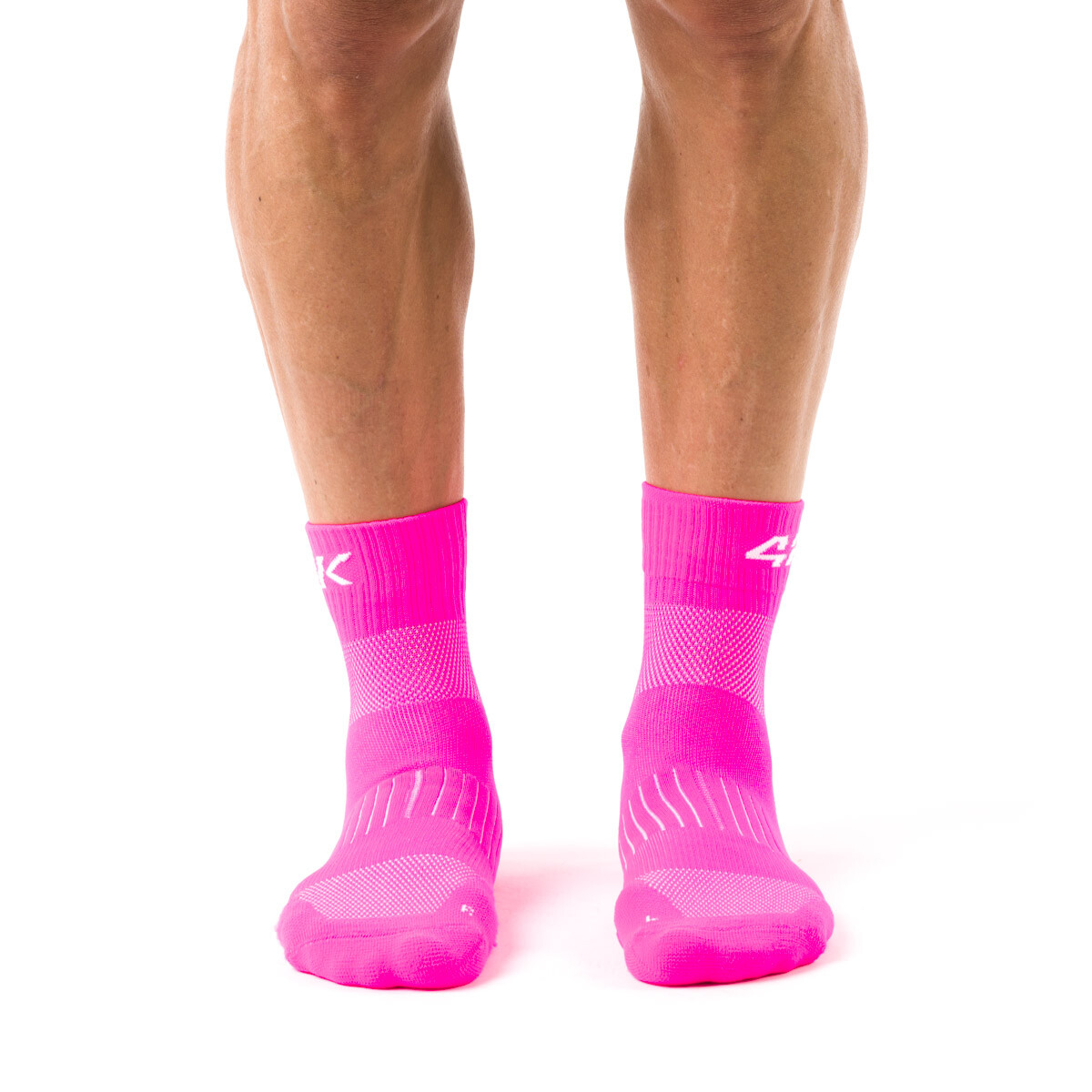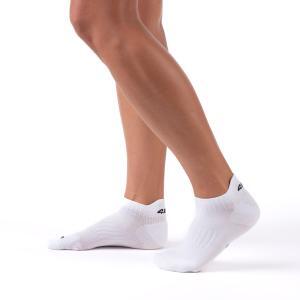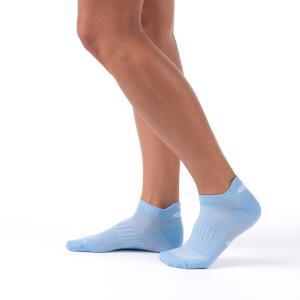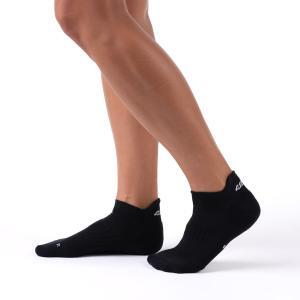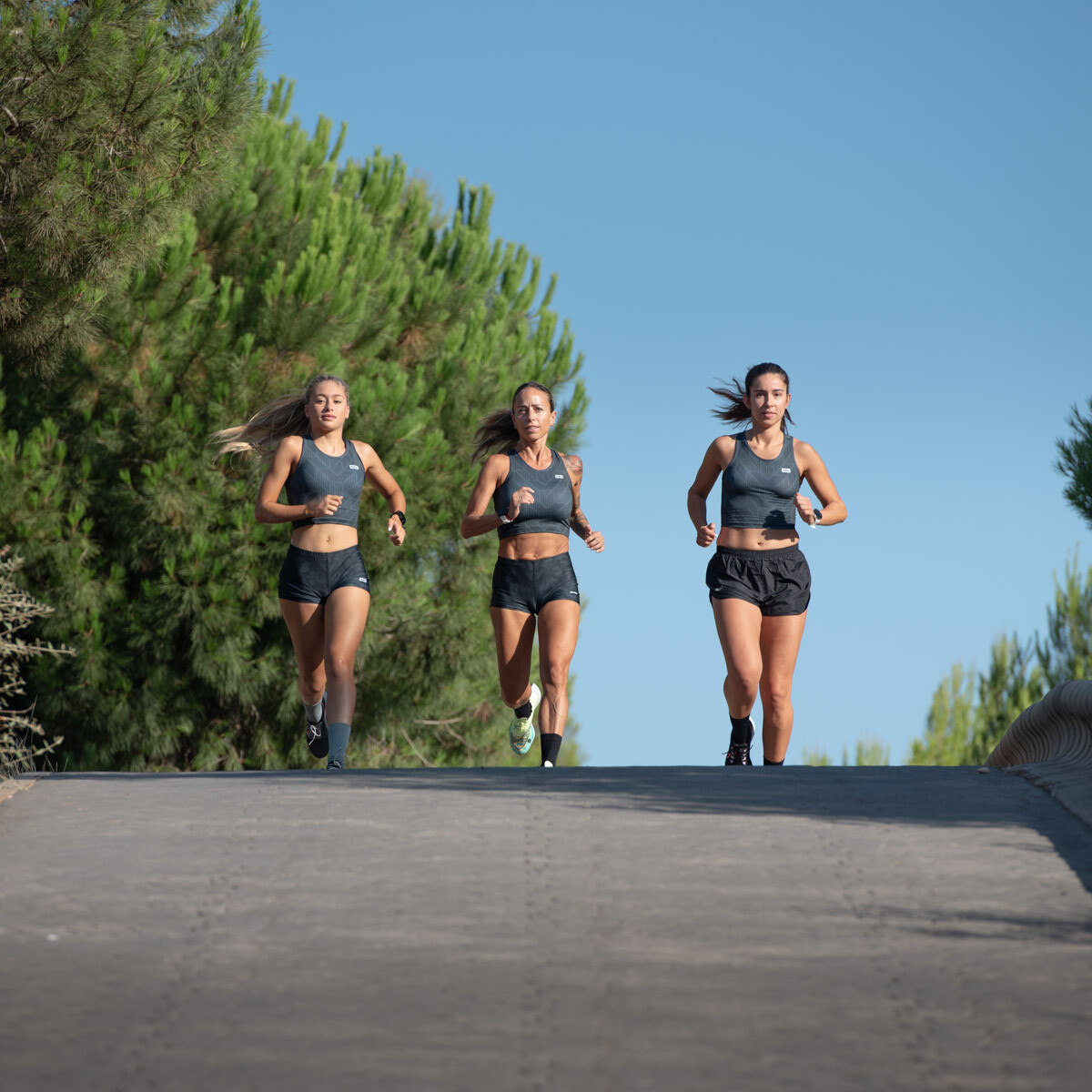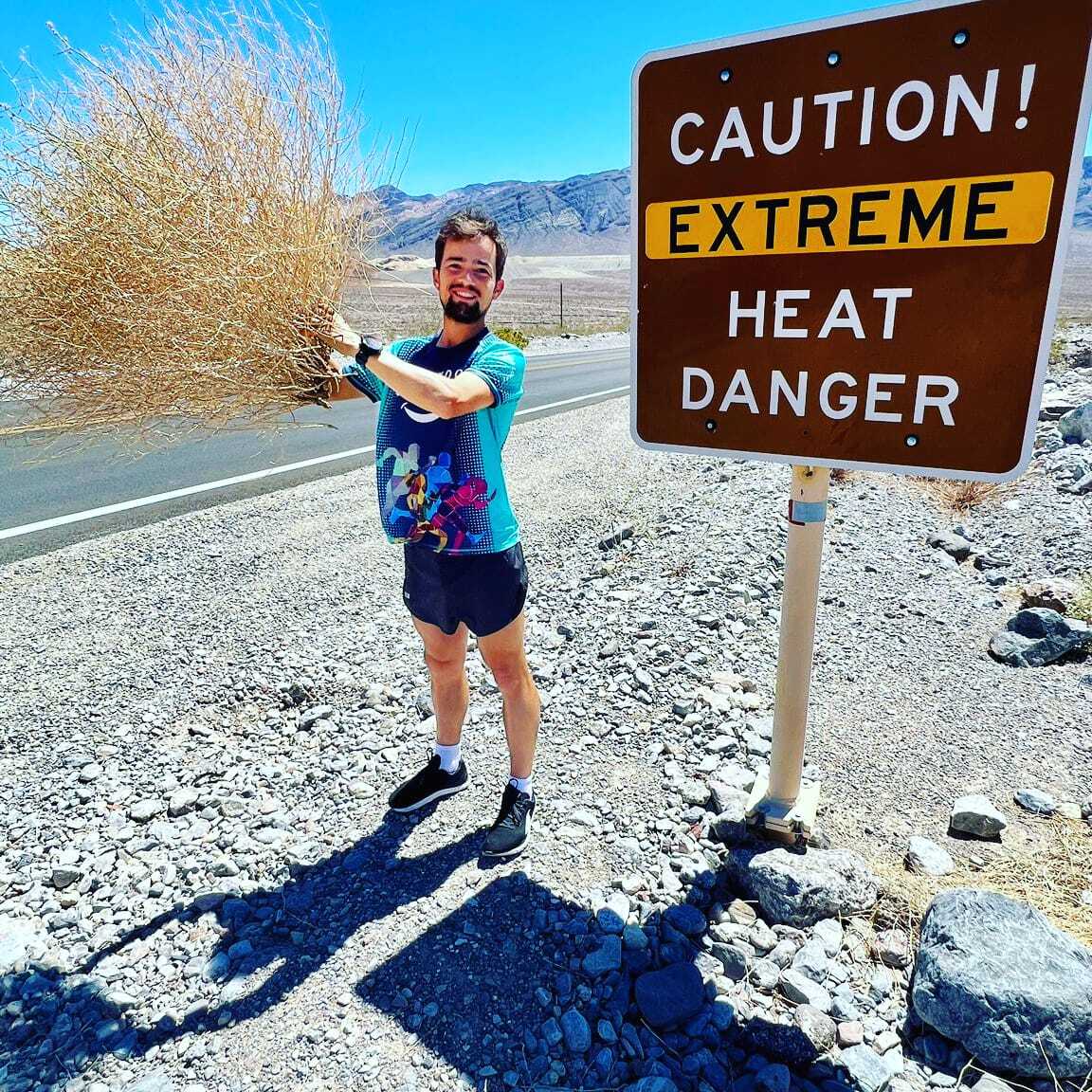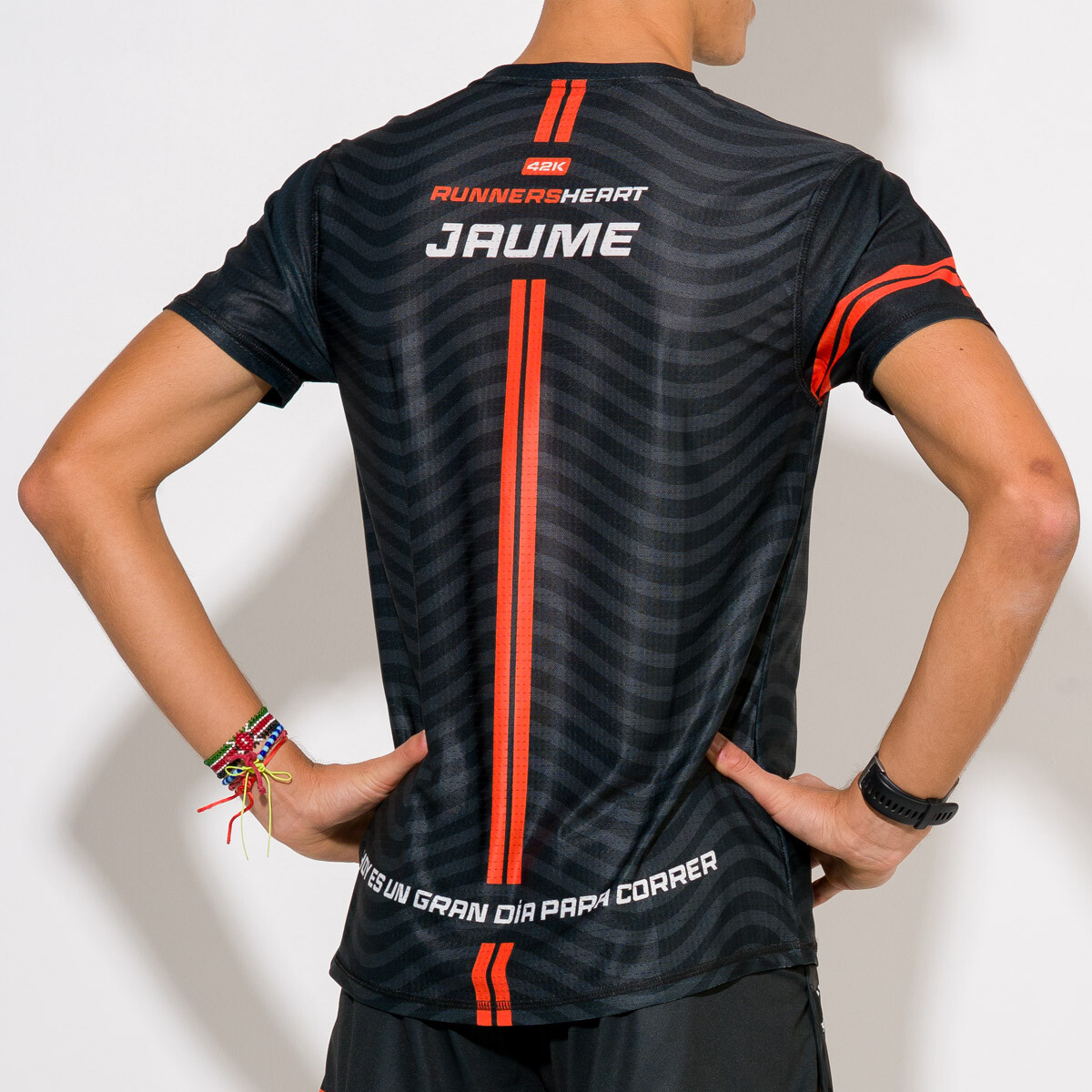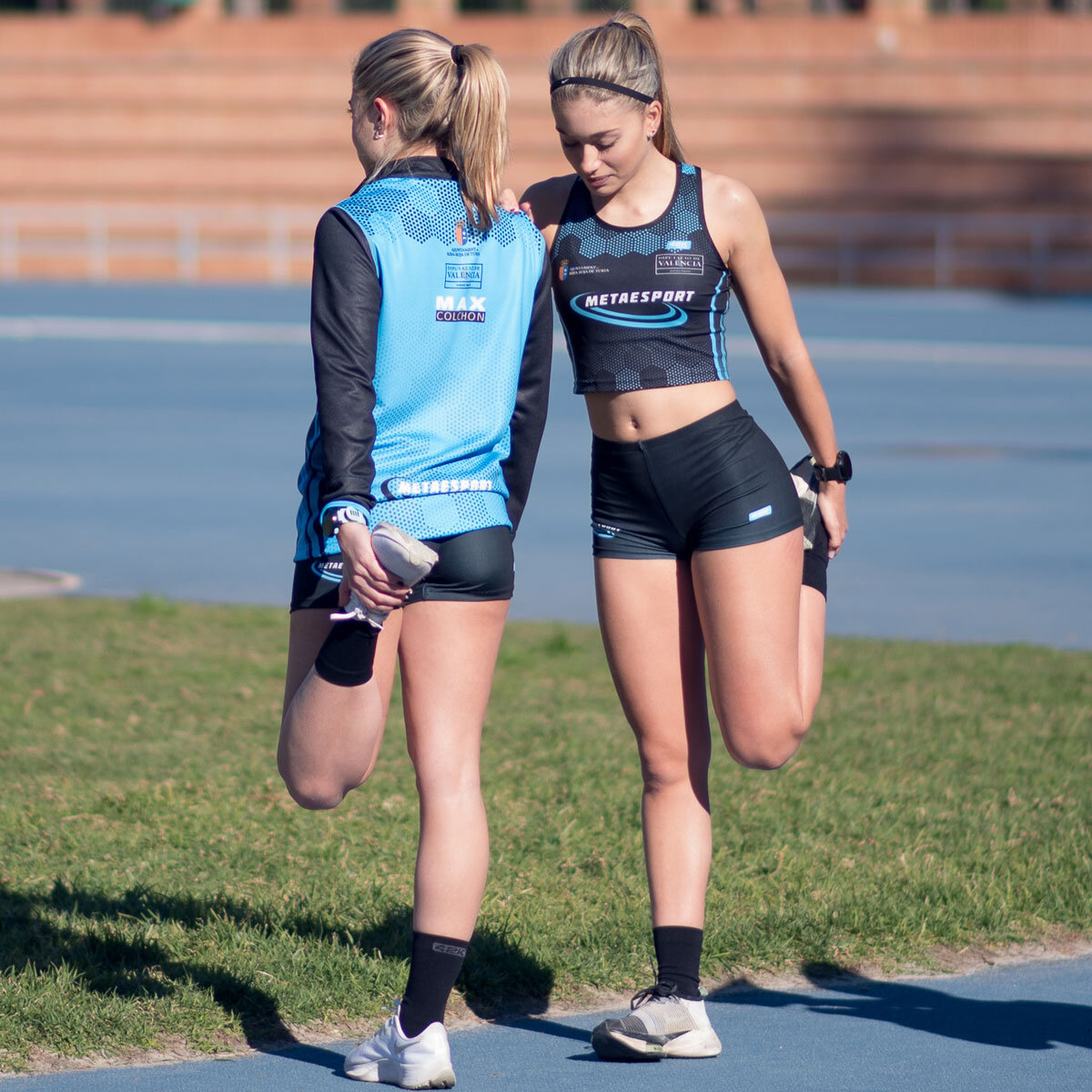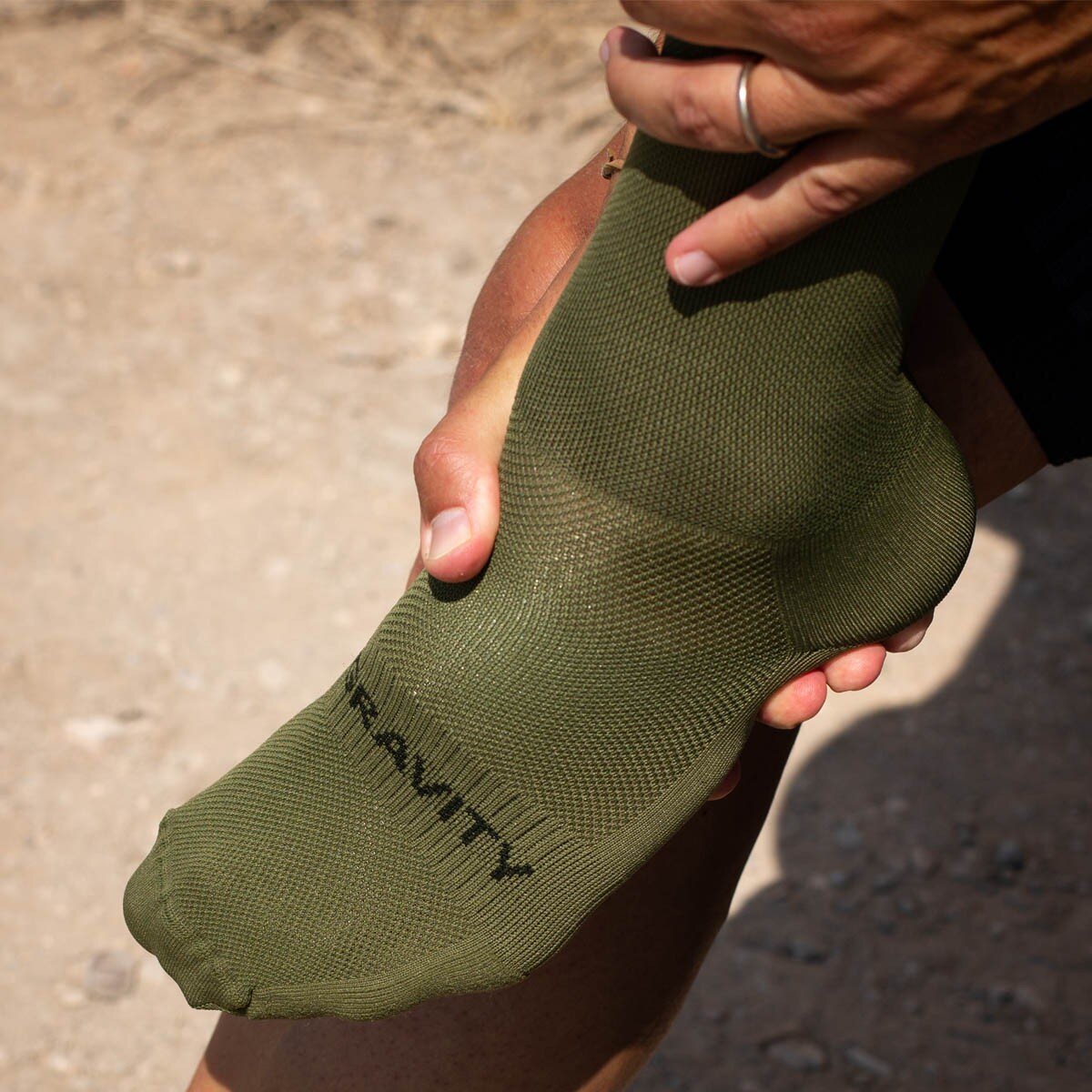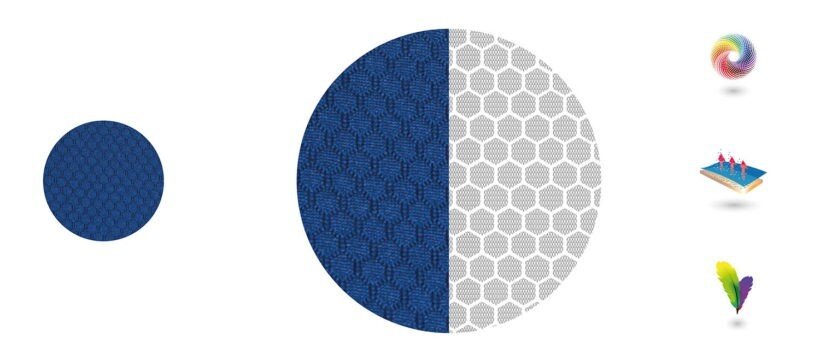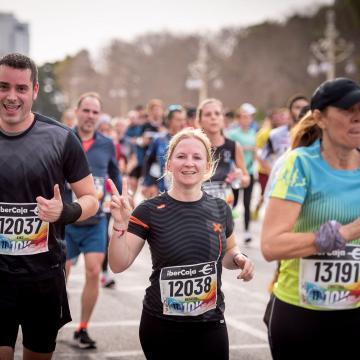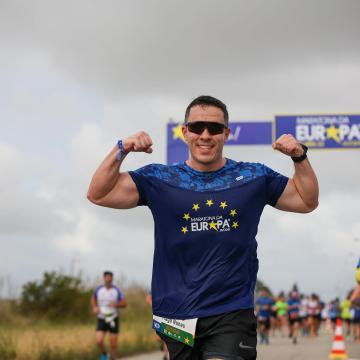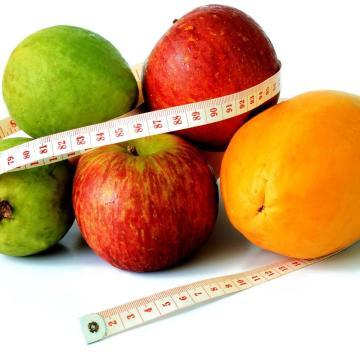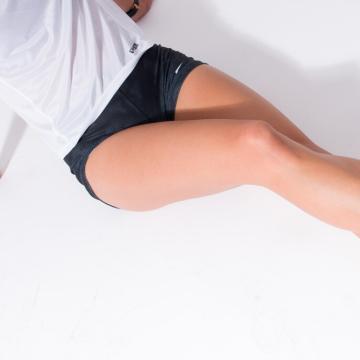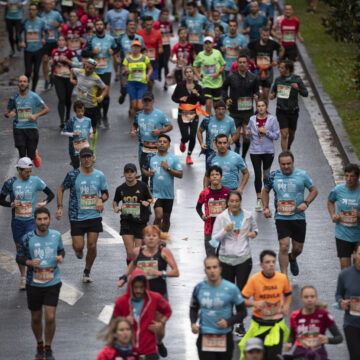Subscribe to our newsletter to find out about all the news and promotions, and automatically receive a welcome discount coupon in your email.
post -> Tips to prepare for a 10k
The 10k has become the popular test par excellence and for many people who are starting out in the running It is the first great competitive challenge in which to defend a number. In this article we are going to offer you tips to prepare for a 10k.
The 10k is a distance that more and more popular runners dare to do every day. The 'boom' of running In the last decade it has meant that many tests of this distance have been born and that almost all cities or towns of a certain entity have their ten thousand meter race.
In many 10k events (it also occurs in distances such as the 15k, the half marathon or the marathon) it is possible to find people who face the distance for the first time without adequate preparation to complete the test within the time allowed by the organization; The problem, however, is not arriving outside the time limit but rather subjecting the body to an effort for which it is not sufficiently prepared.
We have turned to the specialist Marcos Greus, high-performance trainer and coach in endurance sports, to ask for advice for someone who wants to prepare for a 10k (their first 10k) and do it in a sensible way and with the peace of mind of having the necessary preparation to face the challenge.
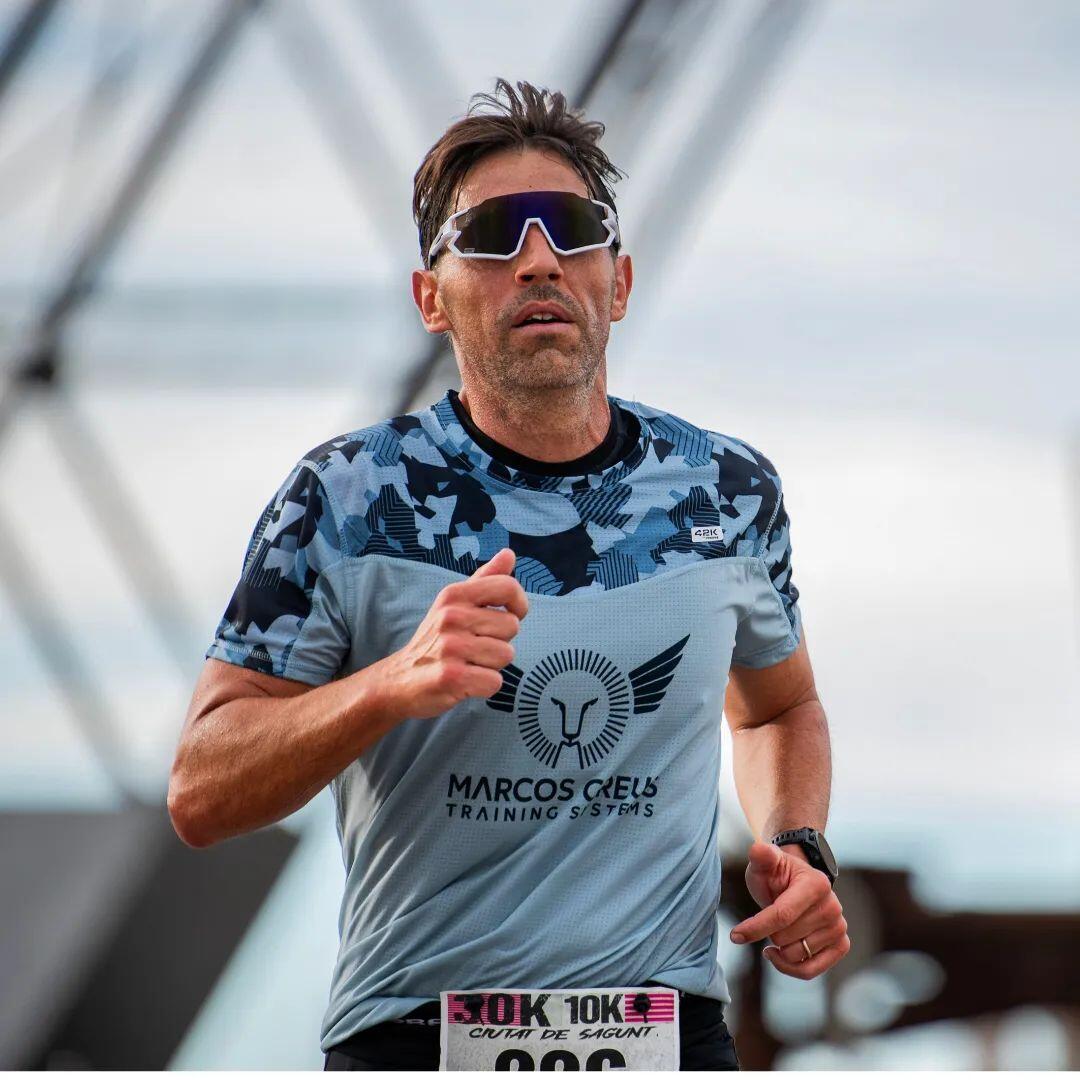
We have asked you a series of questions, taking as a starting point the situation of a popular runner who is already able to endure 30/40 minutes of continuous running, who goes out running 3 days a week and who is willing to increase your training time (plus time per shoot and adding a fourth day of training).
Preparing for a 10k requires being in shape
Preparing for a 10k is usually the first big sporting challenge for many people who get into running. runningIs it really a distance suitable for anyone?
Many people start running for health reasons, to feel well, to reach or maintain an adequate weight... As long as there is no medical contraindication, it is a good decision to start running, but running is a demanding physical activity that requires minimal preparation to avoid scares or problems; I always say that You have to be in shape to start running and not run to be in shape..
When you start running it is very important to be sure that you are in physical shape that guarantees that you are not at risk of injury.
It is more common than we think to find people who start running after a long time of total inactivity, who are overweight (with the risk that this can pose for the joints), without muscle tone and without having a prior medical check-up. And at the height of absurdity there are also cases of people who dare to run starting with popular races, which is a blunder and recklessness.
The boom of running that has been experienced in recent years has meant that many people sign up for races without adequate preparation and in some cases even without having barely run before. I have known cases of people who have signed up for races right away because they said that they found a stimulus to train and motivate themselves to run.
Prepare a 10k requires being in shape as a first requirement and, furthermore, committing to carrying out preparation work that is demanding because we are faced with a distance that seems very affordable (and really is with the right preparation) but that is not within everyone's reach because it involves running for around an hour uninterruptedly. ; It's one thing to run 20-25 minutes and quite another to run 60 minutes continuously..

How long is it advisable to have been running to consider running a 10k with guarantees of finishing it correctly and without problems or taking risks?
In general, my recommendation for anyone would be to face the challenge of preparing for a 10k when you are really sure that you can do it. run between 10 and 12 kilometers with solvency. What do I mean by “solvency”? Well, the cardiorespiratory system, the muscular system and the bone and ligamentous system are capable of supporting 10 kilometers at an easy pace; At that moment and not before is when you should think about tackling a 10k.
Many people go for their first 10k without having gone beyond 7 or 8 kilometers and, fortunately, nothing happens to the majority, but it is a distance in which there are risks that can cause discomfort or even injuries that could be avoided with a little more preparation, perseverance and, above all, patience. In recent years impatience has prevailed in the running popular; Fear and respect for distances have been lost, which is something that seems worrying to me.
When you can run 10 kilometers reliably at an easy pace, it is time to slightly increase the intensity and volume of training kilometers to face a 10k.
And why increase intensity and volume in training? Well, because in a race, inevitably, you will run at a faster pace than in training; When you put on your number it is normal to want to give your best and the body has to be prepared to run at a higher intensity.
Therefore, the sequence of steps to follow before facing the first 10k would be...
First step: Be able to run 10 kilometers with ease at an easy pace.
Second step: When you are already able to run 45-50 minutes three times a week with ease, it would be a good time to think about running a short race, 5 or 7 kilometers, to have a first contact with the competition before making your debut in 10k.
Third step: Increase the intensity and volume of kilometers to prepare the body for the highest intensity that we will demand of it on race day. How to increase the intensity? With short fartleks, such as 10 one-minute changes of pace with breaks (light jogging, without stopping) of 2 minutes. How to increase the volume? Running at a calm pace 12/13 kilometers.

10-12 weeks of specific preparation to prepare for a 10k
How long before the test would it be advisable to start training to adequately prepare for a 10k?
It depends on the starting state of each person; Starting to run from scratch is not the same for a sedentary person as it is for an active person who exercises or practices other sports regularly.
The starting state of each person will be decisive in establishing what type of training, how many days of training and what the appropriate planning should be to aspire to run a race safely and without risk of injury or health problems. .
At this point I want to claim the importance of a professional in Physical Activity and Sports Sciences being the one who determines what the optimal planning is and is also the one who guides the path of preparation; Only a physical preparation professional will be able to objectively determine what a person's starting physical state is and, therefore, what is the most appropriate preparation to face the challenge of preparing for a 10k.
In the case of an active person (not sedentary), who performs physical activity with some regularity and who does not have any physical limitations or medical contraindications, the normal period to prepare for a 10k would be 10-12 weeks of training running 3 times a week and doing at least one day of strength training.
What is essential from the point of view of a physical trainer before starting to prepare for a 10K?
Determine very well what the person's starting point of fitness is. Something very important for me is to make a anamnesis Sports, that is, an analysis of the medical history and personal and family history to be able to adjust the training loads as much as possible to the reality and circumstances of that person.
As I have pointed out before, starting to train a person who is coming from a period of inactivity (whether due to injury or disconnection from sport) or a sedentary lifestyle is not the same as starting to train someone who already does some sporting activity and who, therefore, already has muscle toning or adaptation to start with specific training focused on running.
It is essential to determine the starting point and carefully examine what is in the 'toolbox' of the person who wants to prepare a sporting goal.
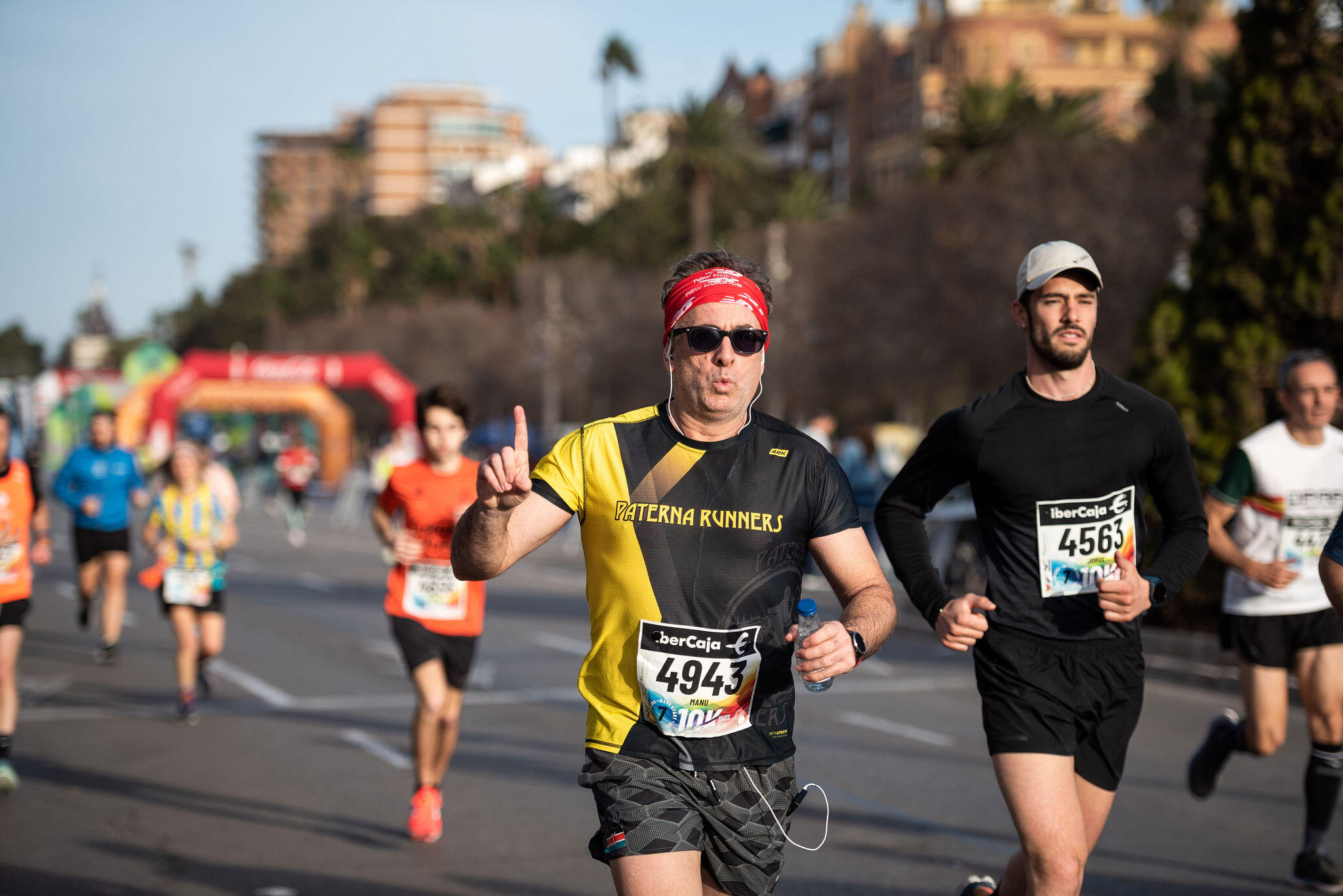
What do I mean by what's inside 'the toolbox'? I'm going to explain it with an example: person and a half on Saturday and Sunday; In person X's toolbox there is also the possibility of going to a gym for one or two days or doing a day of pool training...
With all that information, with everything I know is in person X's toolbox, I can design and build the most efficient training possible to address the sporting goal. That is why I say that for me the initial history of the person/athlete is essential to be able to properly adjust training days and workloads.
Yes, you have to train strength to prepare for a 10k
Is it important to incorporate strength training into preparation to debut in a 10K?
Absolutely yes. Strength is the basis of any physical preparation and it is important to prepare for a 10k. For someone who wants to face a 10k for the first time with the aim of finishing it with solvency but without pretensions of making a mark, specific work in the gym or with weights is not necessary, but a self loading work; This work could be with tires, TRX, on stairs, on slopes...
Strength work is necessary because it will allow train more, better assimilate training loads y reduce the risk of injury. And why do I say that it will allow you to train more? Well, because by doing strength work you can be more consistent in training and in the end the key in any endurance sport is perseverance and patience. The person who is constant, who does not skip or miss workouts, is the one who progresses.
In a 10k you take between 8.000 and 9.000 steps, which means supporting your body weight multiplied by 4 each time you step on the ground; If at the bone, muscle, tendon and ligament level you are not strong enough and prepared to withstand this enormous volume of impacts, discomfort and injuries may appear, and it will be of no use to wear very expensive shoes.
The most common mistake when debuting in a 10k: not keeping pace
What mistakes should you try to avoid when running a 10k for the first time?
The most common mistake of the beginner is usually getting carried away by the emotion of the race and not keeping track of the pace.
Act quickly. avoid going out at inappropriate paces because you end up paying for that after kilometer 7. You have to plan your pace from the start and run with a cool head at all times, but especially in the first kilometers.
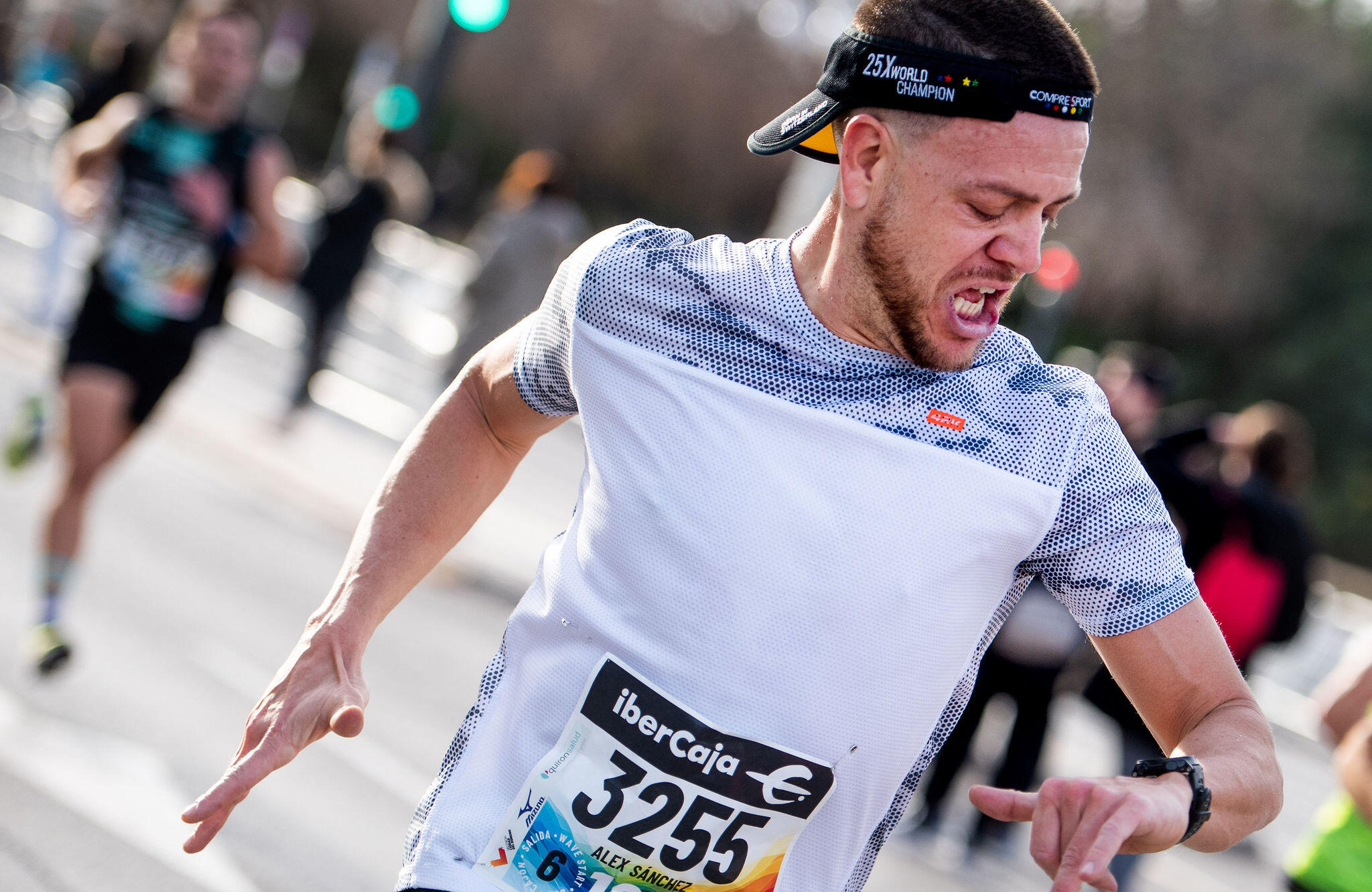
I always tell beginners in any distance, be it a 10k or a half marathon or a marathon, that you have to run at the rhythms or pulses that have been trained and assimilated. You should not overestimate yourself in the first kilometers no matter how good the sensations are; That feeling of believing that the bib number is going to give you that extra performance to run faster throughout the entire route is very treacherous.
Another indication that I always give to the runners I train is that the day before and the day of the race There is no need to do anything that has not been previously trained..
There is no need to do “experiments”. And on race day you don't have a different breakfast, you don't drink more coffee, you don't wear new clothes, much less shoes (which may sound like a joke, but I know of cases), you don't take an energy gel before the race because it's a recommendation from someone with a lot of experience, you don't drink something during the race that you haven't tried before...
On race day you don't have to do anything new; Everything that is done on race day has to be trained and assimilated prior to the race.
What would be important to be clear about before considering putting on a bib in a 10k?
The most important thing is to be clear that you want to run a race. There are many people who end up putting on a bib because of “pressure”. I know of cases of people who sign up because friends or family insist on doing so when they have been running for some time and they do it almost out of obligation.
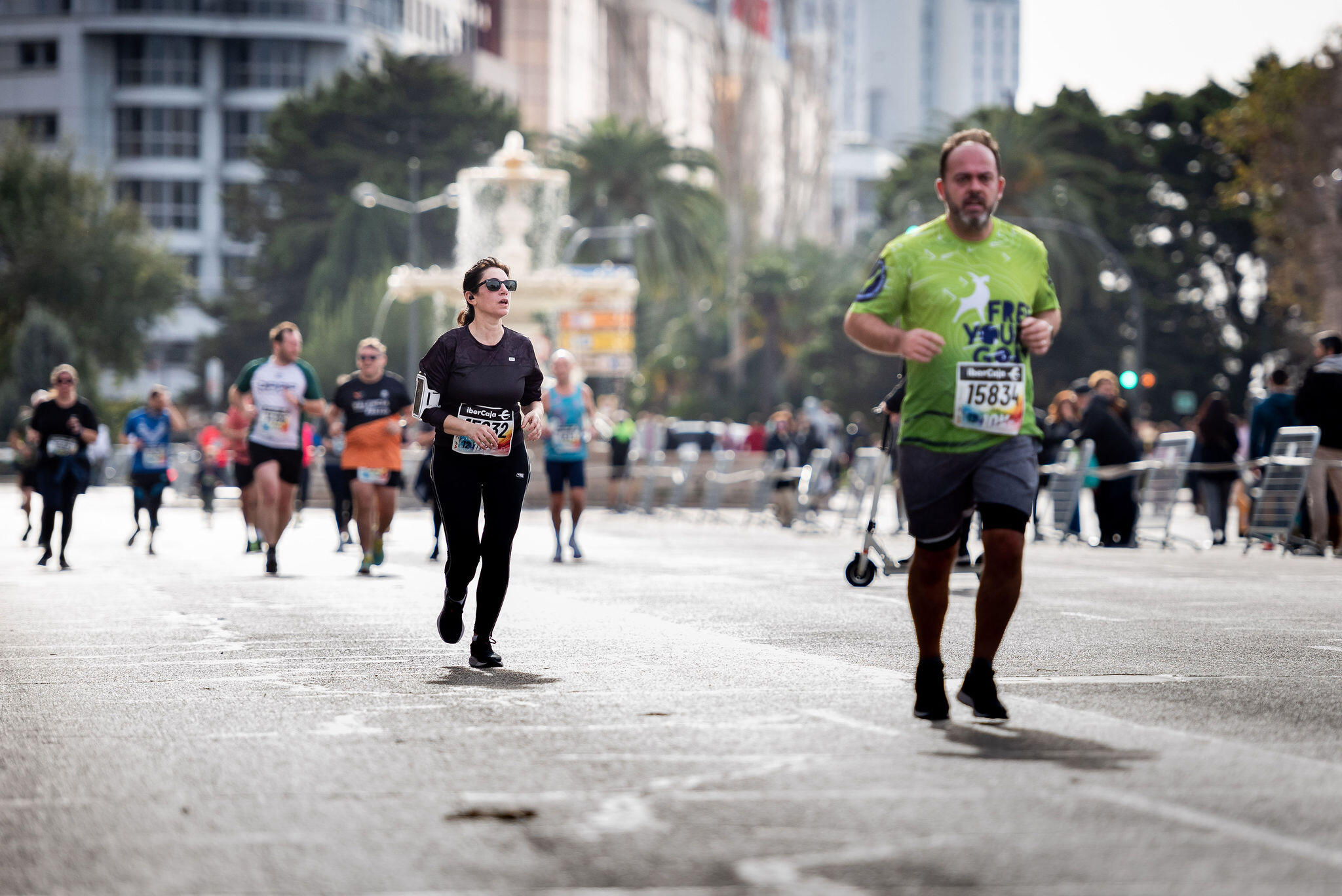
Facing a race, especially for the first time, generates stress that not everyone likes or enjoys. There are many people who like to run for health or for fun or to disconnect and who don't like to compete, and that's okay. Putting on a bib and facing a 10k is something you really have to look forward to. It is absolutely respectable that someone decides to run and has no interest in the competitive aspect.
Do you want to improve as a runner? Put yourself in the hands of professionals. To achieve sports goals, whether elite or popular, you must seek advice from someone who can really help you with judgment, seriousness and professionalism to improve as a runner in the section of training, preparation, nutrition, injury prevention and recovery... etc.
Internet and social reds have been a infinite amount of information available to anyone who is starting out in sports, information that can be very diverse: training, sports planning, nutrition advice, recommendations for injuries...
In many cases this information comes from serious sources, but has been provided in a generic manner, without taking into account the particular case of a specific person or patient. There is also information that comes from very unreliable sources and that should be ignored because in addition to not helping you improve as a runner, it can cause problems for you.
To improve as a runner you have to seek the right advice
We live in a time in which everyone has access to information at the click of a button and in which it is very fashionable to publish content on social reds about sports, nutrition, training... and, of course, physiotherapy.
Many professionals who have studied and achieved the corresponding degrees that accredit our knowledge and, therefore, the competence to offer quality services and advice to athletes, we witness with astonishment, disbelief, patience and, sometimes, indignation at the absurdity of finding, on a daily basis, on social reds people without qualifications or degrees pontificating on subjects about which they have little knowledge.
Some even profit from their advice, recommendations and advice based on knowledge that they do not prove (probably because they lack the required qualifications). Unfortunately, many of their clients are not aware of the risk they run by putting themselves in the hands of people who advise on training-preparation, injury recovery, nutrition or physiotherapy without training and without qualifications to prove their competence.
I am going to try to clarify which professionals can help you achieve your goals (and therefore improve as a runner) and which false professionals put your health at risk due to lack of preparation, lack of knowledge or desire for prominence.
In my opinion there are two basic rules to start dealing with this topic:
- Practicing a sport does not make you a professional specialist in it.. For example, no matter how good you are at playing soccer, you are not a coach; No matter how good you are at CrossFit, you are not a CrossFit coach; and, logically, no matter how good you are at running and no matter how good a time you have in the marathon or 10K, you are not a sports coach. running/athletics.
- The type articles… «7 definitive exercises to have iron legs» o «training to lose 50' in 10K» o "core training to be a better runner" that you find on the Internet or on social reds are not the ones that are going to be best for you (they may even harm you); They are articles written for other purposes (improve positioning, improve visibility, attract attention, gain followers...) but they are not really designed for you.
My advice is that you look for a true professional who is trained (and qualified, because that is a guarantee of having acquired knowledge), updated and, above all, who has experience in what you are looking for, be it training-preparation, nutrition or physiotherapy. If you really want to improve as a runner, don't put yourself in the hands of people

Without health there is no achievable goal
I frequently see people on social media offering information about physiotherapy or injury recovery (which is my professional specialty) without any criteria and, worst of all, without taking into account that giving inappropriate advice can lead to physical problems and even injuries. And injuries, I know from professional experience, destroy people's dreams and sporting aspirations. A phrase that I repeat ad nauseam with my patients and also when I teach classes is "without health there is no achievable goal".
With this article I intend to clarify the role of each of the professionals that you may encounter as a runner in your sporting activity (and to improve as a runner it is very important to be clear about this).
The first thing I want to make clear is that If you have an injury, you should go to a medical professional. to diagnose the injury; From there, I consider it very important to clarify the distribution of roles between physiotherapist, physical trainer and coach:
- Un physiotherapist trabaja so you can train.
- Un physical trainer trabaja so you can compete.
- Un coach trabaja so you can perform.
Are you a patient or client? An important difference
A very important aspect to keep in mind is to know if you are a patient or a client, what difference does it make? Well, very simple: if you are injured or need to prevent injuries In order to train, the professional you should turn to is a physiotherapist, because you are a patient. If you are healthy, you are a client and what you need is a degree in Physical Activity and Sports Sciences.
If you are a patient, you need a physiotherapist
The physiotherapist is the professional who is in charge of improving the injured structure while respecting the tissue healing process; In addition, it works on the sports rehabilitation of the injury or preventing it, based on physiotherapy tests that help ensure that you can train without pain or discomfort to give quality to the training of sports professionals, who are the physical trainers of yesteryear and who Now they are graduates in Physical Activity and Sports Sciences.
A physiotherapist accompanies the athlete when he is injured; and when he is not injured, the physiotherapist can help him prevent with exercises evaluated through functional physiotherapy tests, for example with the Valobando App (you can learn more about what it consists of in the article «The importance of the sports physiotherapist»), generating specific work for the athlete with a health objective, since they are health professionals.
A physiotherapist can make a physiotherapy diagnosis, which, together with a previous medical diagnosis, serves to design recovery work and also serves to avoid relapses.
If you are not injured, you are a 'client' and need a degree in Physical Activity and Sports Sciences
The graduate in Physical Education or currently the Degree in Physical Activity and Sports Sciences is the professional who is in charge of preparing the runner who is healthy (not injured) to compete. If you are not injured, you are not a patient, but a client with a competition goal in mind.
The graduate in Physical Activity and Sports Sciences is the professional who is in charge of, once your physical qualities have been evaluated, preparing you so that you can compete to the maximum and improve as a runner; he is in charge «to look for your best version», which is an expression that is very fashionable now. To improve as a runner, it is essential to have the advice of an expert in physical preparation to be able to get the best out of your physical qualities.
Furthermore, a graduate in Physical Activity and Sports Sciences who is specialized in high performance in endurance sports is the one who can best guide you in planning training to achieve a specific goal.
Now, can a physical trainer readapt an injury? And a second question: can you train a patient with an injury?
The answer to the first question is a resounding NO because it has not been trained for it; Doing so would be a clear example of work intrusion, in addition to putting the 'patient's' health at risk, because a runner who requires rehabilitation due to an injury is a patient and not a client (which is why I previously made the distinction between patient and client).
The answer to the second question is more complicated, but I will try to clarify it: a patient (a runner with an injury) must be supervised by a physiotherapist in the stretcher and readaptation phase to the sport, but is not exempt from working on the physical qualities that your sport requires and that is the part in which the Physical Activity and Sports Sciences technician intervenes, but always under the supervision and tutelage of a physiotherapist.

The physiotherapist and the degree in Physical Activity and Sports Sciences go hand in hand in the training and recovery process of an athlete. It is a professional tandem that can really help anyone interested in that goal improve as a runner.
Once the runner has recovered from the injury, the person in charge of directing the training process is the graduate in Physical Activity and Sports Sciences, but the physiotherapist is obliged to generate the correct situation to that the athlete does not get injured and can train to the maximum with his coach.
At this point I would like to talk about other professional profiles (for some of them it would be more appropriate to talk about 'pseudo professionals'), especially because in recent years they have proliferated on social reds giving all kinds of advice to runners (preparation, nutrition, training, injury prevention, injury treatment, health advice...) and, honestly, I think that many of them cannot help you improve as a runner.
- Massage therapist. Person who has studied a course on how to give massages, but cannot treat pathologies because they have a very poor knowledge of anatomy. You have ‘customers’; You can go to it simply to release muscle tension, but not if you have an injury or pathology.
- Chiropractor. The chiropractic It is based on practices and beliefs that are considered pseudoscience. They are dangerous because with little training in anatomy they manipulate vertebral joints and that can pose risks to people's health.
- Monitor. There are two kinds:
- Room Monitor or Personal Trainer. Normally it is a Higher Technician in Physical and Sports Activities (TAFAD), a Vocational Training qualification that is included within the branch of Sports; They train for two years, but logically they do not have the knowledge of a degree in Physical Activity and Sports Sciences. It is a hybrid between the professional who wants to get the most out of you and get you in shape. There are also 3-month courses, it is a course with little training and low quality.
- Monitor of disciplines such as Pilates, yoga, boxing, swimming, paddle tennis, tennis, etc., they are professionals in activities specialized in a method or sport.
- Druid, shaman, brujo, neighbor with powers, friend who reads hands… They are people who help spiritually and really only help those who believe in superstitions.
- Acupuncturist. Person who inserts needles to perform acupuncture treatments; Not to be confused with physiotherapists or doctors trained in traditional Chinese medicine.
- Expert in nothing and everything. This is a dangerous profile: his sporting experience is all his knowledge and he believes that this qualifies him to coach others. Unfortunately, I have had several examples in my clinic of runners injured by following the advice of that friend. "who has been running for many years and has won several popular races", which is why he considers that he can serve as a coach for anyone.
- Youtuber, content creator, influencer… This is a profile that has grown on social reds and that, in my opinion, has every right in the world to generate content as long as it does not delve into professional fields that have to do with health, and for me health It is nutrition, training, physical preparation, injury recovery, physiotherapy...
In conclusion, I believe that health must be taken very seriously. In general, most true professionals are respectful of their areas of action. Specialization is essential to provide health guarantees to athletes. A physiotherapist cannot delve into the terrain, for example, of a podiatrist, in the same way that a traumatologist cannot act as a nutritionist or a physical trainer cannot determine how recovery from an injury should be done.
42K has renewed its entire socks catalog running with 3 new collections in three different measures: 22 cms, 14 cms y ankle braces.
Three new collections of technical socks from running and multisport to satisfy all tastes of cane heights: Ingravity2 (22 cm), Etna2 (14cms) y Low Run (ankles).
Socks running with three shaft heights
The socks catalog running 42K has grown with the incorporation of three new collections different in terms of style and shaft height, but with a common denominator: excellent technical quality at an unbeatable price.
All socks 42K They are designed and developed to meet the expectations of the most demanding runners. Like all products 42K They have been tested in different terrains, distances (races and/or training from 1 hour to 5 hours) and circumstances (different intensities and rhythms; in heat and cold...) by runners of 42K to verify that its performance is optimal.
Ingravity2, socks running high cane
The Ingravity2 It is designed for those runners who are looking for socks. running de tall cane with minimalist design discreet colors. They have 22 centimeters of shaft height and offer maximum comfort for running, triathlon, cycling or Nordic walking.
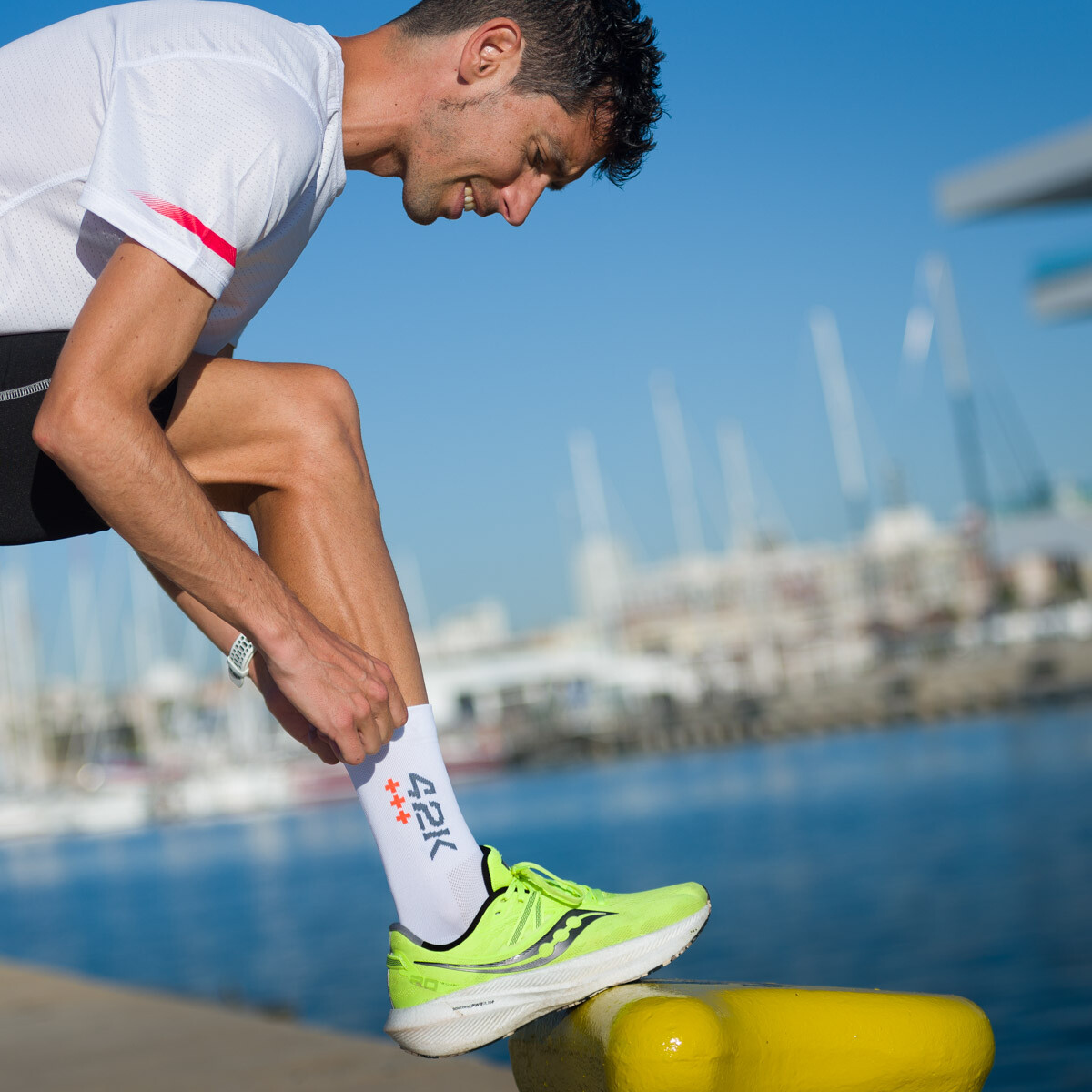
Its fabric and design make it feel like a second skin thanks to its semi-compressive fit. guaranteesn a excellent performance during sports practice, both in short distances and in long runs, standing out for its comfort, breathability and durability.
The Ingravity2 are manufactured with VAPORFEEL PURE®, a material of high resistance to abrasion and impacts which makes them very durable. Another of its properties is that it transports moisture to the outside and keeps your feet dry. In addition, VAPORFEEL PURE® incorporates bactericidal action and antimicrobial which neutralizes possible discomfort and bad odors caused by bacteria and fungi on the skin.

Another of the singularities of this collection is that it incorporates a new treatment grip which favors the anti-slip of the foot
The Ingravity2 wear the logo 42K embroidery on the exterior side and are available in four colors: navy (blue), black, white y grey.
with these socks running Some of our athletes have already competed in long-distance events, such as Carmen Pérez and Sete Cerdán, in the demanding Climb to Pico Veleta (Carmen was the female winner), a 50-kilometer (+2.705m) test in the socks Ingravity2 demonstrated magnificent performance during the almost 5 hours of racing in the middle of August and on the hot Granada asphalt.

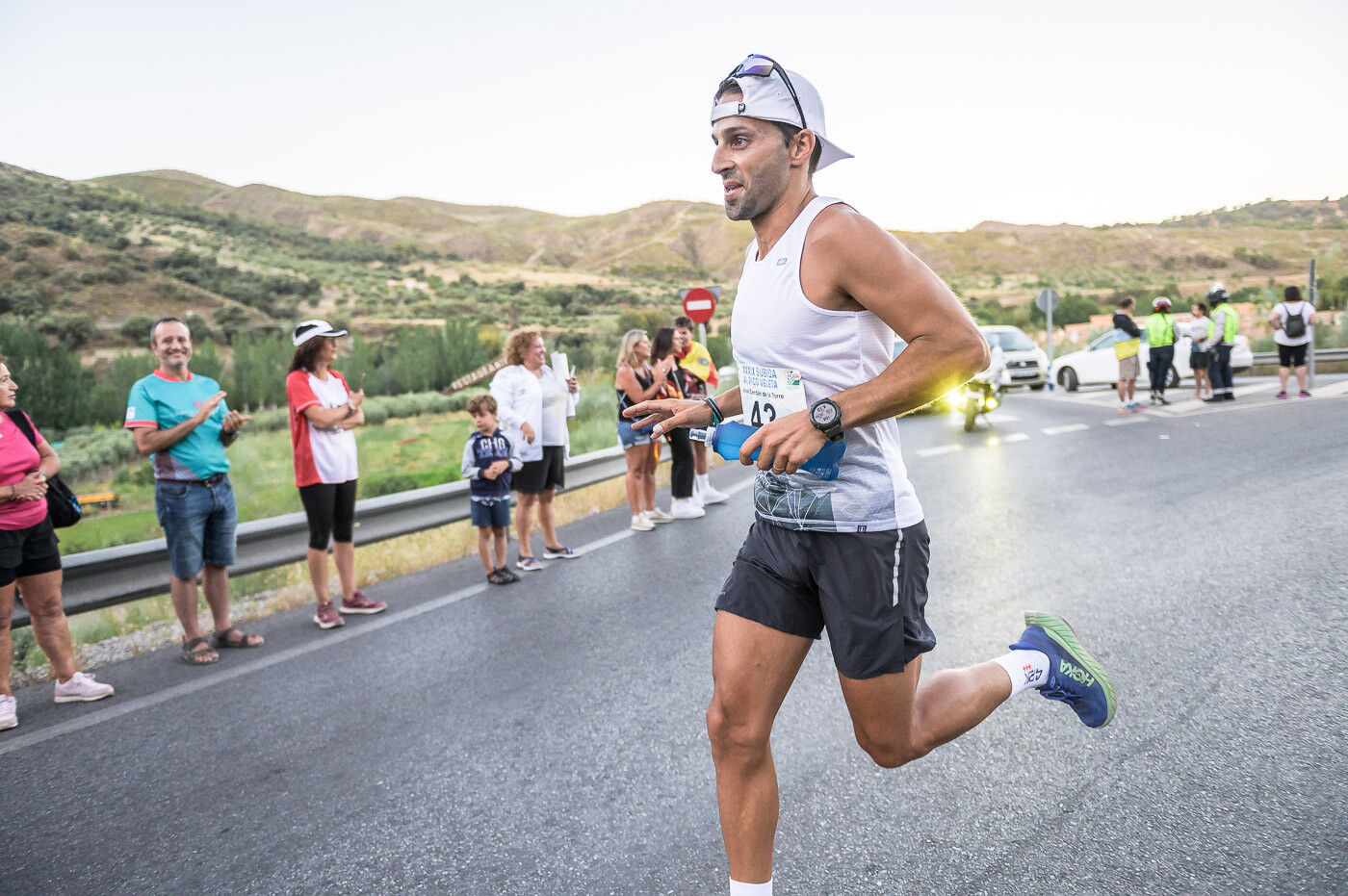
Etna2, socks running 14 cm
A few years ago we named one of the most successful collections of technical socks after the famous Sicilian volcano Etna. 42K.
The etna2 They are a total renewal of the successful Etna sock by 14 cms and are perfect for runners, both on asphalt and in the mountains, who want a high-performance technical sock of Average height y semi-compressive fit.
New ones have been incorporated into the Etna2 fluorine colors for those runners who want to put a striking splash of color to your strides, although they are also available in black and white for more classic runners.
The main improvement and novelty of the Etna2 is the preparation with VAPORFEEL®, a material used by some of the most important sports brands on the market to manufacture high-performance technical socks.
The thermal properties of VAPORFEEL® (especially optimal for humid climates) facilitate the transport of the sweat to the outside which helps keep feet dry, minimizing the risk of blisters and ensuring a high level of comfort in all types of training or short, medium and long distance races.
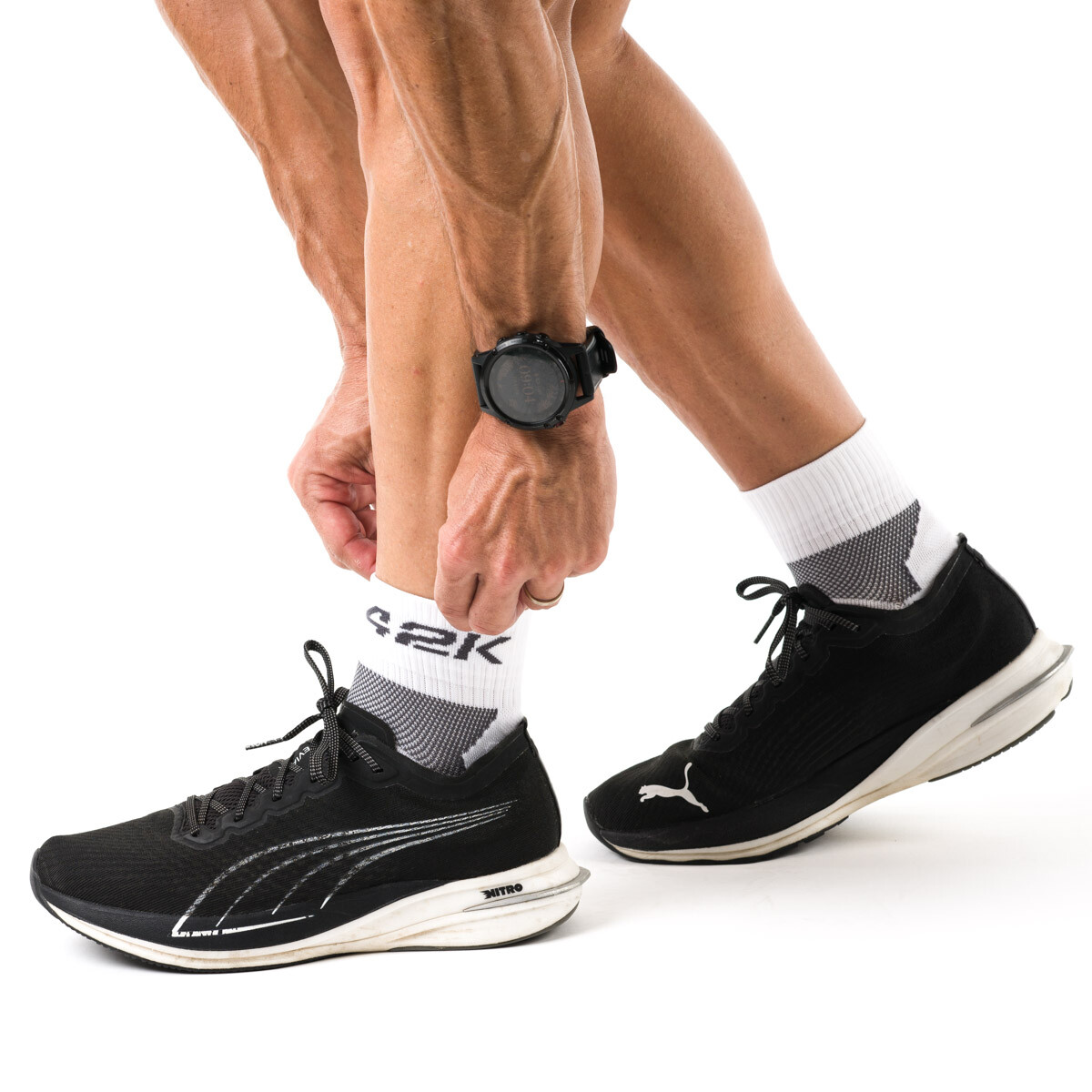
This material allows us to create technical socks that are perfect for intensive practice of running in hot or humid environments thanks to its optimal sweat evacuation capacity.
Incorporate reinforcements and specially padded areas en toecap, metatarsals, heel y Achilles tendon to provide protection and cushioning to the parts of the foot that can suffer the most during running.
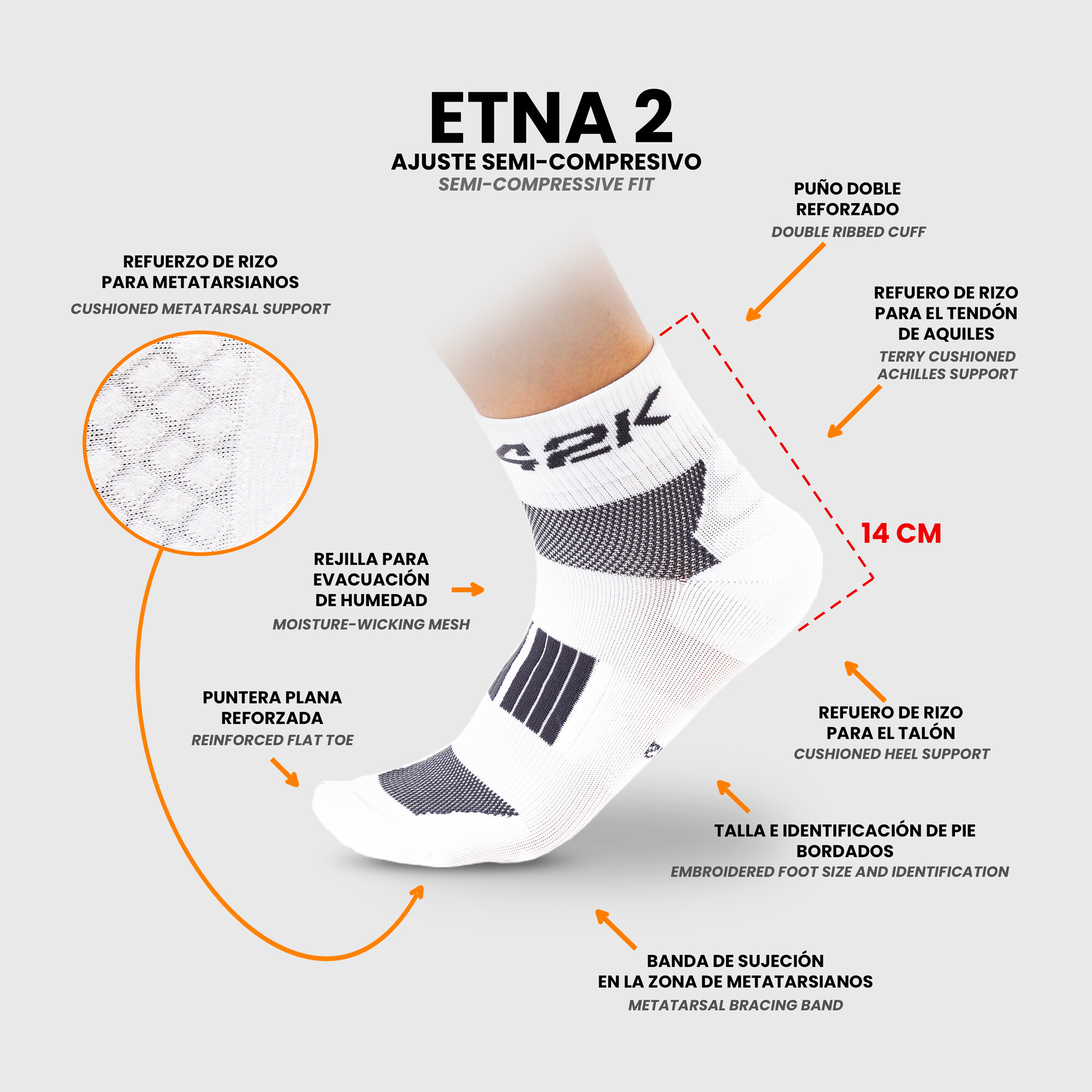
The Etna2 collection is made up of five colors: three fluorine (pink, yellow y orange), white y black.
Low Run, socks running ankle braces
The Low Run is the latest to join the catalog of technical socks for running and multisport 42K.
These are ankle socks fine tissueThanks to its 1 thread sewing, and are ideal for runners who want a light sock almost invisible that feels like a second skin.
The height of the shaft is at ankle level to offer protection against any possible friction with the collar of the shoe and on the back it has a special tab to avoid discomfort with the buttress.
Like the Etna2 collection, they are made with VAPORFEEL®, a high-density material that stands out for its lightness and resistance to abrasion, with optimal thermal properties for humid climates by transporting sweat to the outside and keeping feet dry to reduce the risk of blisters forming.
they have reinforcements and terry zones specially padded in the required areas (toe, sole and heel) to avoid discomfort from chafing.

The Low Run collection is made up of 3 colors: white, black y light sky blue.
The importance of good socks running
Choosing good technical socks is the best guarantee to enjoy the running. People who are starting out in the world of running They mistakenly believe that any sports sock is valid for running and that is not the case. The choice of Inappropriate sports socks can cause problems (irritations, chafing and even blisters) if used for regular running or long-term training.
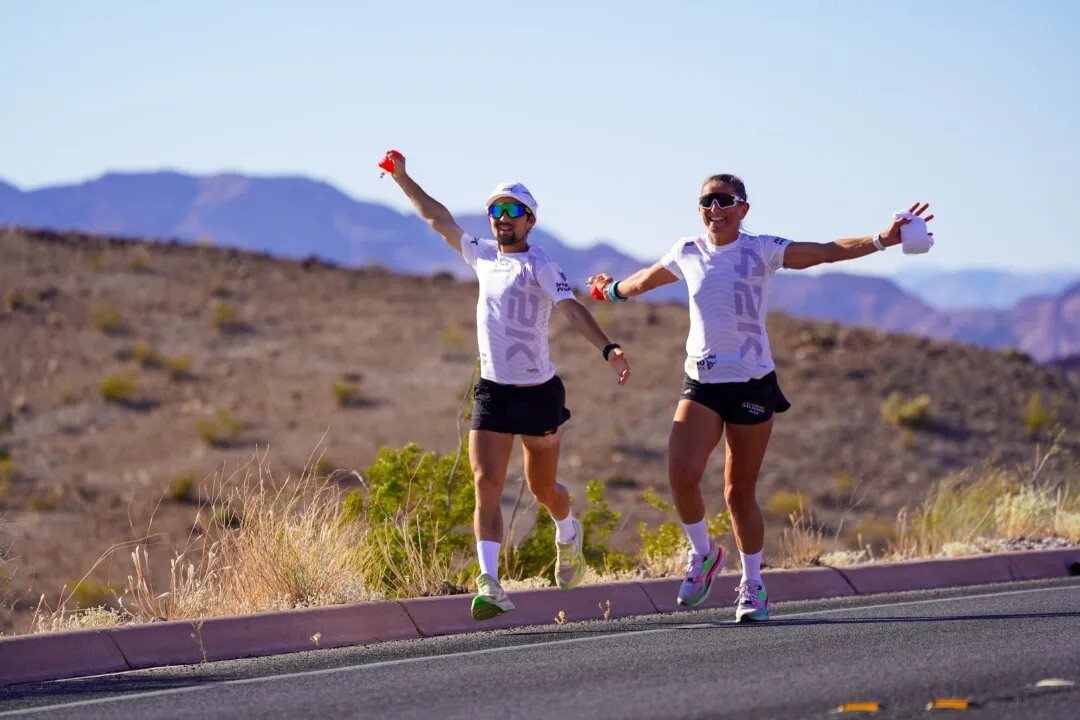
As we explain in another article on this blog titled Technical clothing to start running, the feet are one of the parts of the body that any runner must especially take care of and that is why the correct choice of specific socks for them is so important. running.
A Pair of healthy and problem-free feet They are necessary in any sport that involves running, but it is essential when the sport being performed is running.
And to enjoy the running With healthy feet you have to choose the appropriate technical material in terms of shoes and socks. In the case of choosing socks running You have to make sure that they guarantee good grip y protection of the most delicate areas of the foot, as well as correct evacuation of sweat to the outside to avoid risks of irritation or softening of the skin.
42K commitment to the preparation of its different collections of socks running by high-quality technical fabrics that stand out for their qualities of elasticity and fit, breathability (important in any sports sock, but essential in a sock for running) Y durability.
Socks running made in Spain
All socks running 42K are made in Spain and are offered in savings-packs that allow their purchase with a 10% discount on the unit price.
- 2 pack socks running and trail running in black and white.
- 14 cms. high (from the base of the heel to the cuff).
- Adjustment semi-compressive.
- Maximum protection and cushioning in the sensitive parts of the foot.
- Made with VAPORFEEL®, very light material and resistant to abrasion and impacts.
- VAPORFEEL® keeps the correct foot temperature and favors a fast drying.
- Composition: 67% VAPORFEEL®, 21% elastic, 8% Lycra and 4% nylon.
- Reinforced flat toe.
- curl reinforcement in zone of metatarsals for added cushioning.
- Support band in the metatarsal area to prevent displacement.
- mesh instep for moisture evacuation.
- curl reinforcement in the heel.
- curl reinforcement in the area of Achilles tendon.
- double fist reinforced for a perfect hold.
- Logo 42K embroidery on the cuff of the cane.
- Identification of right foot (R) and left foot (L).
- Size S: 37-39 | Size M: 40-42 | Size L: 43-45.
- Exclusive online store 42K.
- Made in Spain.
Conservation recommendations for ETNA2:
- Wash maximum at 30º.
- Use gentle washing process.
- Do not use whiteners (bleach or other chemical products).
- Do not iron.
- No tumble dryer.
- Drying vertically in the shade.
- Do not dry clean.
- 3 pack socks running and trail running in fluorine colors (yellow, fuchsia and orange).
- 14 cms. high (from the base of the heel to the cuff).
- Adjustment semi-compressive.
- Maximum protection and cushioning in the sensitive parts of the foot.
- Made with VAPORFEEL®, very light material and resistant to abrasion and impacts.
- VAPORFEEL® keeps the correct foot temperature and favors a fast drying.
- Composition: 67% VAPORFEEL®, 21% elastic, 8% Lycra and 4% nylon.
- Reinforced flat toe.
- curl reinforcement in zone of metatarsals for added cushioning.
- Support band in the metatarsal area to prevent displacement.
- mesh instep for moisture evacuation.
- curl reinforcement in the heel.
- curl reinforcement in the area of Achilles tendon.
- double fist reinforced for a perfect hold.
- Logo 42K embroidery on the cuff of the cane.
- Identification of right foot (R) and left foot (L).
- Size S: 37-39 | Size M: 40-42 | Size L: 43-45.
- Exclusive online store 42K.
- Made in Spain.
Conservation recommendations for ETNA2:
- Wash maximum at 30º.
- Use gentle washing process.
- Do not use whiteners (bleach or other chemical products).
- Do not iron.
- No tumble dryer.
- Drying vertically in the shade.
- Do not dry clean.
- Socks running and trail running in fluorescent fuchsia.
- 14 cms. high (from the base of the heel to the cuff).
- Adjustment semi-compressive.
- Maximum protection and cushioning in the sensitive parts of the foot.
- Made with VAPORFEEL®, very light material and resistant to abrasion and impacts.
- VAPORFEEL® keeps the correct foot temperature and favors a fast drying.
- Composition: 67% VAPORFEEL®, 21% elastic, 8% Lycra and 4% nylon.
- Reinforced flat toe.
- curl reinforcement in zone of metatarsals for added cushioning.
- Support band in the metatarsal area to prevent displacement.
- mesh instep for moisture evacuation.
- curl reinforcement in the heel.
- curl reinforcement in the area of Achilles tendon.
- double fist reinforced for a perfect hold.
- Logo 42K embroidery on the cuff of the cane.
- Identification of right foot (R) and left foot (L).
- Size S: 37-39 | Size M: 40-42 | Size L: 43-45.
- Exclusive online store 42K.
- Manufactured in Spain.
- Available 5 colors: white, black, fluorine yellow, fluorine orange and fluorine pink.
Conservation recommendations:
- Wash maximum at 30º.
- Do not use bleach (bleach or other chemicals)
- Do not iron.
- Do not tumble dry.
- Drying vertically in the shade.
- Do not dry clean.
- Socks running and trail running in fluorescent orange.
- 14 cms. high (from the base of the heel to the cuff).
- Adjustment semi-compressive.
- Maximum protection and cushioning in the sensitive parts of the foot.
- Made with VAPORFEEL®, very light material and resistant to abrasion and impacts.
- VAPORFEEL® keeps the correct foot temperature and favors a fast drying.
- Composition: 67% VAPORFEEL®, 21% elastic, 8% Lycra and 4% nylon.
- Reinforced flat toe.
- curl reinforcement in zone of metatarsals for added cushioning.
- Support band in the metatarsal area to prevent displacement.
- mesh instep for moisture evacuation.
- curl reinforcement in the heel.
- curl reinforcement in the area of Achilles tendon.
- double fist reinforced for a perfect hold.
- Logo 42K embroidery on the cuff of the cane.
- Identification of right foot (R) and left foot (L).
- Size S: 37-39 | Size M: 40-42 | Size L: 43-45.
- Exclusive online store 42K.
- Manufactured in Spain.
- Available 5 colors: white, black, fluorine yellow, fluorine orange and fluorine pink.
Conservation recommendations:
- Wash maximum at 30º.
- Do not use bleach (bleach or other chemicals)
- Do not iron.
- Do not tumble dry.
- Drying vertically in the shade.
- Do not dry clean.
- Socks running and trail running in fluorescent yellow.
- 14 cms. high (from the base of the heel to the cuff).
- Adjustment semi-compressive.
- Maximum protection and cushioning in the sensitive parts of the foot.
- Made with VAPORFEEL®, very light material and resistant to abrasion and impacts.
- VAPORFEEL® keeps the correct foot temperature and favors a fast drying.
- Composition: 67% VAPORFEEL®, 21% elastic, 8% Lycra and 4% nylon.
- Reinforced flat toe.
- curl reinforcement in zone of metatarsals for added cushioning.
- Support band in the metatarsal area to prevent displacement.
- mesh instep for moisture evacuation.
- curl reinforcement in the heel.
- curl reinforcement in the area of Achilles tendon.
- double fist reinforced for a perfect hold.
- Logo 42K embroidery on the cuff of the cane.
- Identification of right foot (R) and left foot (L).
- Size S: 37-39 | Size M: 40-42 | Size L: 43-45.
- Exclusive online store 42K.
- Manufactured in Spain.
- Available 5 colors: white, black, fluorine yellow, fluorine orange and fluorine pink.
Conservation recommendations:
- Wash maximum at 30º.
- Do not use bleach (bleach or other chemicals)
- Do not iron.
- Do not tumble dry.
- Drying vertically in the shade.
- Do not dry clean.
- Socks running and trail running in black.
- 14 cms. high (from the base of the heel to the cuff).
- Adjustment semi-compressive.
- Maximum protection and cushioning in the sensitive parts of the foot.
- Made with VAPORFEEL®, very light material and resistant to abrasion and impacts.
- VAPORFEEL® keeps the correct foot temperature and favors a fast drying.
- Composition: 67% VAPORFEEL®, 21% elastic, 8% Lycra and 4% nylon.
- Reinforced flat toe.
- curl reinforcement in zone of metatarsals for added cushioning.
- Support band in the metatarsal area to prevent displacement.
- mesh instep for moisture evacuation.
- curl reinforcement in the heel.
- curl reinforcement in the area of Achilles tendon.
- double fist reinforced for a perfect hold.
- Logo 42K embroidery on the cuff of the cane.
- Identification of right foot (R) and left foot (L).
- Size S: 37-39 | Size M: 40-42 | Size L: 43-45.
- Exclusive online store 42K.
- Manufactured in Spain.
- Available 5 colors: white, black, fluorine yellow, fluorine orange and fluorine pink.
Conservation recommendations:
- Wash maximum at 30º.
- Do not use bleach (bleach or other chemicals)
- Do not iron.
- Do not tumble dry.
- Drying vertically in the shade.
- Do not dry clean.
- Socks running and trail running in white with black details.
- 14 cms. high (from the base of the heel to the cuff).
- Adjustment semi-compressive.
- Maximum protection and cushioning in the sensitive parts of the foot.
- Made with VAPORFEEL®, very light material and resistant to abrasion and impacts.
- VAPORFEEL® keeps the correct foot temperature and favors a fast drying.
- Composition: 67% VAPORFEEL®, 21% elastic, 8% Lycra and 4% nylon.
- Reinforced flat toe.
- curl reinforcement in zone of metatarsals for added cushioning.
- Support band in the metatarsal area to prevent displacement.
- mesh instep for moisture evacuation.
- curl reinforcement in the heel.
- curl reinforcement in the area of Achilles tendon.
- double fist reinforced for a perfect hold.
- Logo 42K embroidery on the cuff of the cane.
- Identification of right foot (R) and left foot (L).
- Size S: 37-39 | Size M: 40-42 | Size L: 43-45.
- Exclusive online store 42K.
- Manufactured in Spain.
- Available 5 colors: white, black, fluorine yellow, fluorine orange and fluorine pink.
Conservation recommendations for ETNA2:
- Wash maximum at 30º.
- Use gentle washing process.
- Do not use whiteners (bleach or other chemical products).
- Do not iron.
- No tumble dryer.
- Drying vertically in the shade.
- Do not dry clean.
Enjoy of running and completing training (if you have sports goals that require it) in summer may seem difficult, but it can be done. Running in summer without problems is possible as long as we apply good sense and take some precautions.
We have already lost count of the very hot days (heat waves occur more and more frequently) that we have been suffering this summer and those of us who live in coastal areas (in Valencia, as is my case), in addition, we have to dealing with the humidity, which still makes everything a little more difficult when it comes to running.
In this article I am going to offer you a series of tips or recommendations on how to train in summer. Many runners in Spain, especially those with sports goals in the second half of the year (Berlin marathon, Lisbon marathon, Majorca marathon, the Porto marathon, the New York marathon, the Athens marathon or the Valencia marathon, among other major events that are usually attended by many Spaniards) have to run in the summer to continue planning their training sessions.
Running in summer: recommendations for optimal and safe performance
Summer is a time of the year in which many runners take the opportunity to take their training to the aire free, enjoy the sun and good weather (as long as the thermometer does not go off and the supposed good weather turns into a curse). Running in the summer airBeing free in the countryside, the beach, the mountains or the parks of any city is a satisfaction that sometimes we cannot afford in winter and we try to take advantage of during the summer months or on vacation.
The high temperatures and Sun exposure can present additional challenges to run in summer. To ensure optimum performance and stay safe during the hottest months it is essential to make certain adjustments in training and take certain precautions.
Below we are going to see a series of recommendations to avoid possible risks and dangers (dehydration, burns, heat stroke, poor performance...), to continue enjoying the running and summer training.
Follow these 10 tips for running in summer
1. Choose the hours well: early in the morning or late in the afternoon.
Avoid doing workouts in the hottest hours of the day, usually between 10:00 a.m. and 18:00 p.m.; In some parts of Spain, especially in mountainous or high altitude areas, it is possible to train before 18:18 p.m., but in coastal areas, and especially on hot and/or humid days, it is better to wait for the temperature to drop after 19:XNUMX p.m. XNUMXh or XNUMXh.

Opt to train early in the morning or late afternoon, when temperatures are cooler and there is less exposure to the sun (and also solar radiation is less harmful).
2. Hydrate.
Proper hydration is essential to run in summer without exposing yourself to unnecessary risks.
There are people who do not give due importance to hydration and it is a huge mistake. If you go running in summer, do it always, always, with agua. There can be no excuses with this issue because it is much easier than it seems to suffer from dehydration (intense heat + insufficient fluid intake = dehydration). In addition, we must bear in mind that even if we do not feel thirsty, we must drink regularly to avoid scares, since sometimes you may not feel thirsty and be at risk of dehydration.
Include in your day to day a greater contribution of mineral salts during the summer as heat and sweat can lead to rapid dehydration. Be sure to drink sufficient water before, during and after of your training sessions (I want to underline the "before" and also the "after", because hydration is not important only during physical exercise).

When you go out to train take a bottle of water with you and, in case of doing a long run or training in the mountains, plan your routes to pass by sources or places where you can refill your bottle.
consider bringing isotonic drinks to replenish lost electrolytes, especially if you plan to train for a longer duration.
2. Equip yourself appropriately: light clothing and a hat.
Running in summer with the right clothes is something that seems obvious, but on more than one occasion I have seen people running in the middle of summer in long leggings, sweatpants, cotton t-shirts that do not allow perspiration...
Choose breathable and light-colored sportswear which helps you stay cool and quickly dries sweat. It may seem silly but light colors will help you feel less hot during your workouts. There are studies that state that there can be a difference of between 8º and 10º between light and dark clothing; light clothing is usually around 35º during the practice of running, while dark colored clothing can reach 43º.
In addition, I also consider it important to wear caps (highly recommended to reduce head temperature), visors and, of course, sunglasses to protect your eyes from UV rays.
3. Wear sunglasses.
La use of sunglasses It is of great importance for running in summer. Unless you train in hours of low light, the use of sunglasses is highly recommended. In addition to protecting your eyes from ultraviolet rays, they will also protect them from eye fatigue, dryness due to loss of moisture and unforeseen dangers that can cause discomfort or injury to your eyes: insects, sand, tree branches, stones fired by a vehicle...

En 42K They have different models of sports glasses designed exclusively for running that you can know in your Online store.
4. Protect yourself from the sun.
It is important to protect yourself from ultraviolet radiation (UV) throughout the year, but in summer it is especially important because the level of intensity of ultraviolet radiation is higher (even on cloudy days you have to take precautions). The sun's ultraviolet rays are strongest between 10 a.m. and 4 p.m., so avoid exposure to the sun without adequate sun protection during that time slot.
I'm not going to lie to you: putting on sunscreen is not something I am excited about, but I consider it essential and non-negotiable. Skin protection must be taken very seriously and there is no other choice but to use a good sun cream to prevent something as serious as skin cancer.
Don't skimp on sunscreen for summer runs and, if you can, use one sunscreen special for sports use that is Waterproof and sweat; apply a generous amount to all exposed areas of the skin (don't forget the ears and lips, although for lips you can use specific products so they do not dry out) before going for a run and reapply every two hours, especially if you sweat a lot .

La OCU indicates that, as a minimum, it is necessary to use protective creams with a protection index 15 (SPF 15), but recommends, like all the experts, to use sun creams with a higher protection index. To stay calm and know that we will be adequately protected, it is convenient to use cream with a sun protection factor (SPF) from 30 to 50 (high protection) in the case of clear skins y sun protection factor +50 (very high protection) in the case of very light or kids skin.
The cream should not be put on when going for a run; you have to apply it 30 minutes before sun exposure, so that sunscreens are absorbed by the deepest layers of the skin and thus fulfill their role of protection.
Proper sun protection helps prevent burns and reduces the risk of skin cancer. Skin cancer cases have increased alarmingly in recent decades. According to 2022 data from the World Health Organization, each year there are between 2 and 3 million new cases of skin cancer.
5. Warm up and stretch.
Since the heat can cause the muscles to be more tense, it is highly recommended to perform a good proper warm up before running.
Performs joint movements y dynamic stretches soft to prepare your body. After your workout, when 8-10 hours have passed, take time to stretch again to improve flexibility and reduce risk of injury, and don't forget to hydrate. I insist once again on the importance of hydration, especially in summer, also when you are not training.
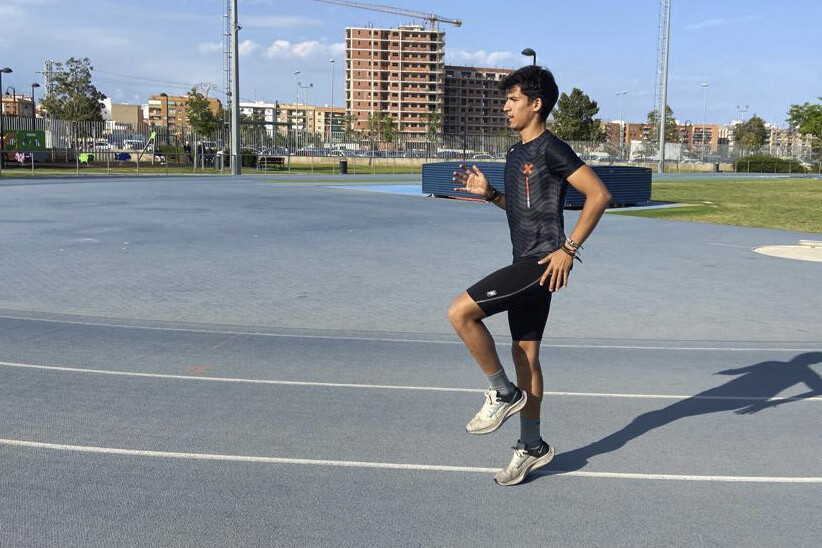
6. Progressive adaptation.
If high temperatures are new to you, use common sense and allow your body to gradually adjust to the heat. Start with shorter workouts and lower intensities and as you feel more comfortable, increase the duration and intensity of your sessions.
Listen to your body. Pay attention to the signals your body is sending you during training. If you feel dizzy, nauseated, or experience cramping, stop the activity and find a cool place to recover.
7. Plan your routes.
Route planning is especially recommended in case we plan to go for a run in the mountains or countryside. Choose routes that have shade and that they are well ventilated. Parks or trails in wooded areas can be ideal options for running in the summer.
If you plan to go out on a mountain route, calculate very well the time it can take to complete it to have enough water.
8. Train with company.
Running in the summer in a group is more fun to forget about the heat. In addition, training with a company can be safer and more motivating during hot days since, in case of an emergency, you will always have help nearby.
9. Slow down.
Slow down your training paces and try to train by pulsations to have control at all times of how the heat affects your body.
In summer the temperature of the airand causes body temperature to rise. When the body temperature is higher the heart is forced to beat faster in order to pump harder and send more blood through the skin (which means less blood to the muscles, which increases the heart rate). ).
The heat can affect your performance, since in summer the heart rate rises quite a bit, so don't worry about your pace. Listen to your body and accept that during the summer it is normal for your speed to be a little lower. In summer, less is more.
10. Post-workout cold shower.
At the end of your session, take a shower with cold water to lower body temperature and help muscle recovery.
And here are my 10 tips for running in summer without problems. I want to remember that each person is different, so it is important to adjust these recommendations to your needs and physical conditions.
In summer we must listen to the body more than ever to be able to enjoy the running in a safe and healthy way.
With adequate training and the necessary precautions, you will be able to maintain your level of physical fitness, enjoy the aire free and make the most of the summer.
Don't stop running in summer, but do it with your head.
Happy kilometers of running in summer!
Iván Penalba wants to conquer the Bathwater 135 and be part of the history of the toughest race in the world. In 2022, in his first participation, he finished second and became the first Spaniard to get on the podium.
His great challenge for 2023 is to conquer the Badwater 135, a race he first faced in 2022 and which has become his biggest challenge sports. «I already know what I'm facing and I think I can dream of victory. Last year I ran it for the first time and everything was new to me. It is a race that is not comparable to any other in the world, so the best experience is to have run it to know what you are facing. », explains Iván Penalba.
Iván Penalba aspires to victory and with record time
La Bathwater 135 It is considered the most extreme and challenging long distance competition in the world. Their 135 miles (217 kilometers) They travel through one of the most inhospitable places on the planet: Death Valley (The death Valley), a desert valley found in southeastern California, in the Mojave desert. It is one of the hottest places in the world in summer, with temperatures that during the day touch and even exceed 50 degrees Celsius and at night, in the best of cases, they drop to 34 degrees.

As a curiosity, in the Valley of Death the record for the highest temperature recorded in the world is set: 134 °F (56.7 °C), on July 10, 1913.
In 2022, Iván Penalba became the seventh Spaniard selected to face the 135 miles of the Badwater. She prepared herself thoroughly -including training in a sauna to accustom her body to extreme temperatures- and finished in second position with a time of 24h:02′:57″, behind the Japanese Yoshihiko Ishikawa, who completed the course in 23h:08′:20″ and repeated his 2019 victory.
The Valencian ultra-distance runner made history by becoming the first Spaniard to get on the podium of the race, but he returned from American lands with the dream of returning to Badwater 135 to win and set a new time record (the men's record is held by Valmir Nunes at 22:51':29" and the women's is held by Jamie Donalson at 26:16':12").
«The Badwater It is not a normal ultrafund test; It requires a very particular preparation, both physically and psychologically. It is an extreme race because the temperatures are hellish and any physical activity becomes very difficult. Last year I prepared the best way I could and knew how, but I didn't know exactly what I was facing. This year I already know what I'm facing and what I need to improve in my preparation and approach to the race.", comments the Valencian athlete.
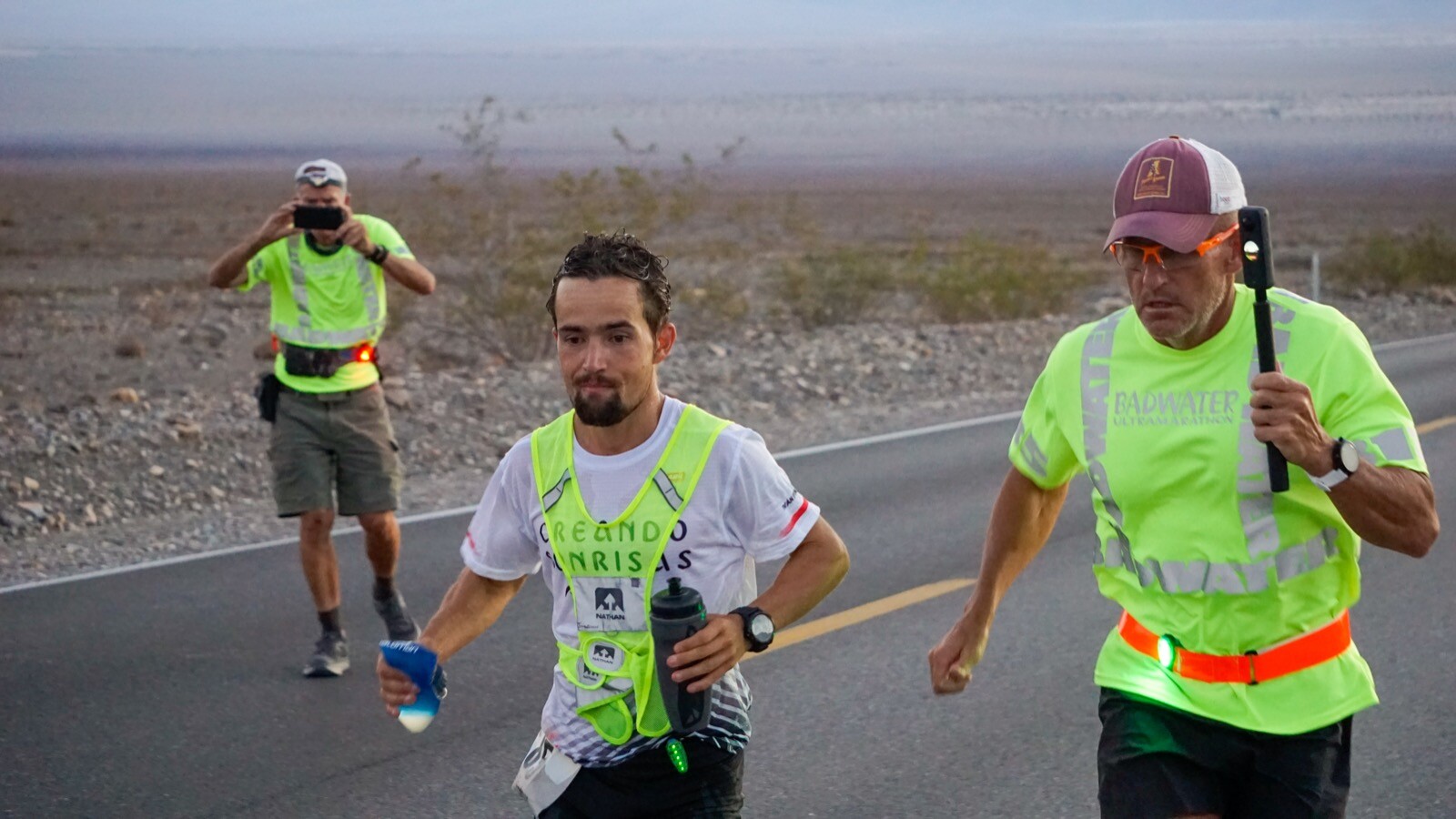
The greatest demand and hardness of the Badwater 135 lies in being able to run for hours on end with hellish temperatures, as Iván Penalba explains. «You have to have exceptional physical preparation, but you also have to work hard on psychological preparation because the hardest thing in this case is not the distance itself (217 kilometers), but the effort involved in maintaining concentration and a competitive pace with a heat that is not describable. And a fundamental aspect to maintain concentration and be able to aspire to victory, as I saw in 2022, is having a very experienced support team.
Carmen Pérez, inseparable companion of fatigues of Iván Penalba
Iván Penalba will have a highly qualified team this year to assist him in his great sporting challenge of the year. Leading the team will be Joaquin Candel, a Spaniard living in Las Vegas who knows the Bad like no one elsewater 135 and all its singularities, both administrative and logistical-sports. And to help you on the burning asphalt of endless roads, you will have the company of two elite ultra-long distance runners: the Mexican Oscar Hernandez y Carmen Perez Serrano.
Both are following a strict training program to be able to provide the help that Penalba will need on July 4 during the more than twenty hours that he will have to run without interruption.
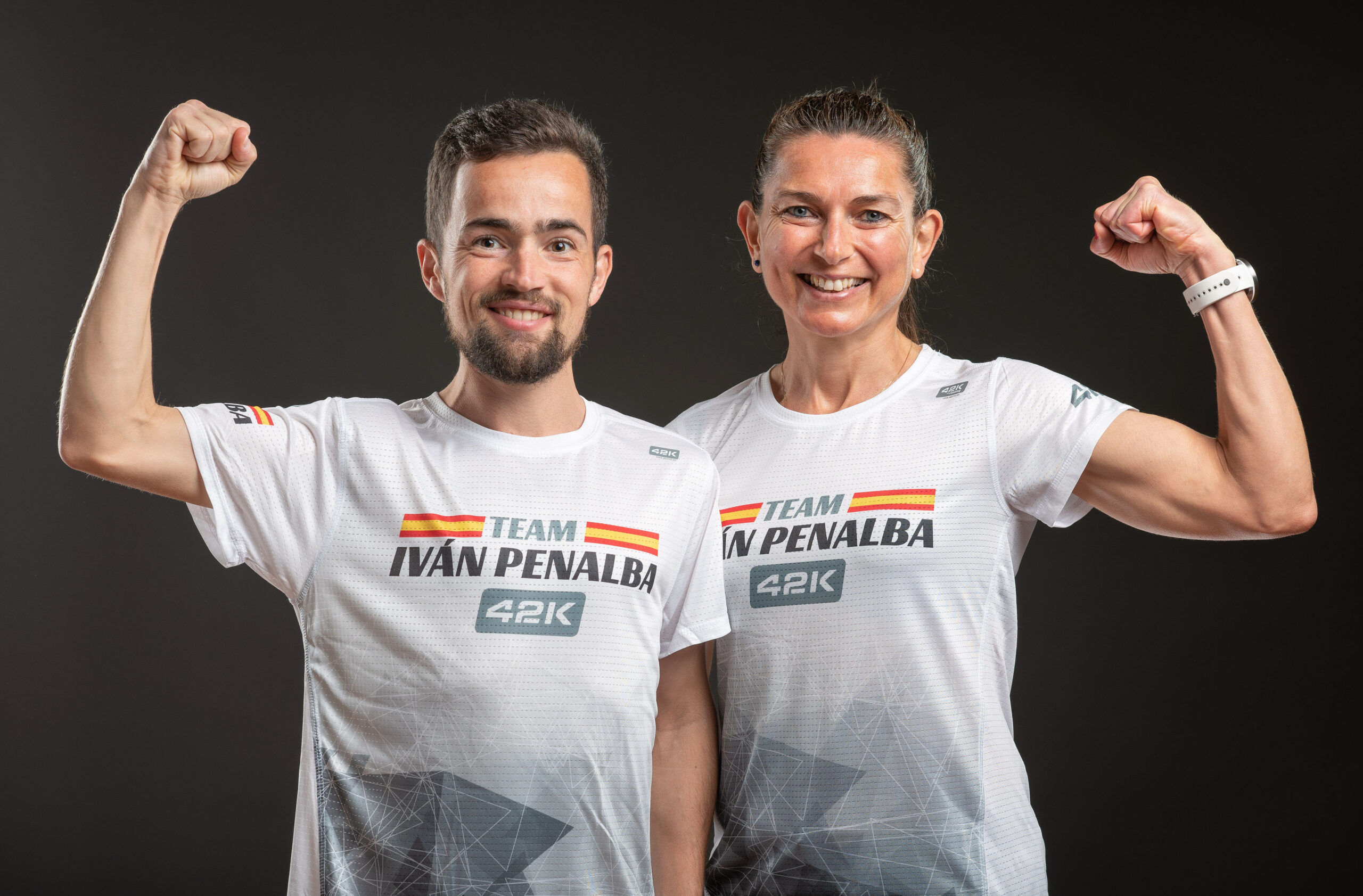
Carmen, Iván's inseparable companion, accumulates extensive experience in ultra-distance tests (both on asphalt and in the mountains) and currently holds the Spanish women's 100 km record (7h:47':14″, mark achieved in the 100 Kilometer World Championship in Berlin 2022), as well as the Spanish records of 6H and 12H.
Joaquín Candel, Carmen Pérez and Oscar Hernández will be the three athletes who will accompany the runner from Alfafar (Valencia) on the ground in the great challenge, but the 'Team Penalba' is also made up of physiotherapists David Valenzuela (Box 55) and Pablo Salvador, physical trainer Sebastian Bialobrzeski, psychologist Pedro Quesada and chiropodists Salva Jesuardo and Nuria Gil.
Iván Penalba's roadmap for Badwater 135
the badwater 135 is the great sporting challenge of 2023 for Iván Penalba and that is why he has designed his competition calendar thinking of reaching his best form until the month of July.

The competition roadmap began on February 25 in the 100 km of Conero (Italy), where he finished in third position with a time of 7h:03':17". February was the first month of his specific preparation for Badwater and finished it with 685,2 km in 26 days (26,5 km/day on average).
The second race of the year in which he competed was the 12 Hours of Sofia (Bulgaria), the first race in which he ran with Carmen Pérez and in which he finished in first position by completing 146,6 km (136,300 kms Carmen). «The 12 Hours of Sofia was the first event in which we competed together and we were able to experience the sensations of work and joint effort. Achieving maximum understanding is essential in the face of Death Valley.", Explica.
Already in April they formed on the starting line of the 24 Hours of Venice, a race in which Penalba also climbed to the top of the podium after totaling 254,03 km (the sixth time he has managed to exceed 254 km in a test 24 hours), while Carmen Pérez finished in the second position of the women.
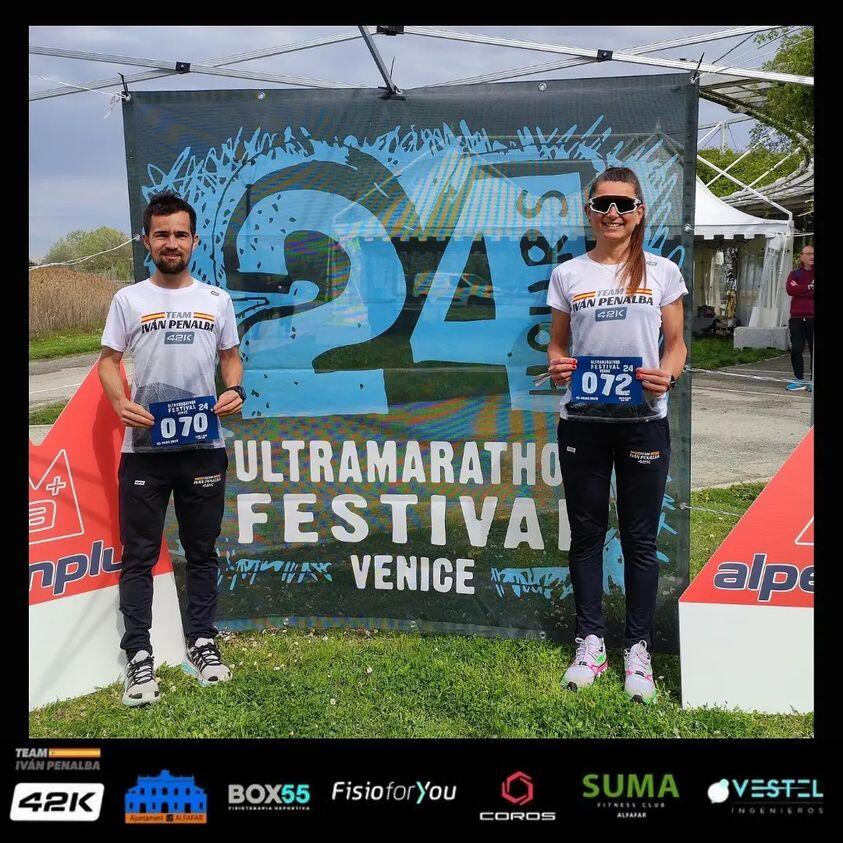
With the 24 Hours of Venice, Iván Penalba already adds to his sporting record a total of 62 official ultra-distance races, with 9 24-hour races completed.
«I am very satisfied with the performance in the first three months of the year. Everything is going the way I wanted. In the first block of 'training - tests' I have run three official ultra-distance competitions in 49 days, totaling more than 500 kilometers, and I have achieved 3 podiums. In addition, I am also satisfied because in each of these competitions I have done many nutrition, hydration, etc. tests, which will be relevant for the Badwater», Explica.
The roadmap of competitions that will serve to refine the set-up for Death Valley includes the following tests:
- 24 Hours of Ciudad Real. In this ultra-distance test on the track, Iván and Carmen will compete in the 3-hour test.
- Camí de Cavalls 360 (Menorca). A test that runs along the GR 223, a historic path of 185 km that goes around Menorca along the coast. In this test Carmen competes and Iván will be in charge of the assistance.
- 100 km from Passatore (Italy). This test that takes place between Florence and Faenza is considered one of the most important 100 km tests in Europe.
- 6 Hours from Tegueste. This will be Penalba's last competition before traveling to Death Valley.
A little history of the Badwater 135
Until 2022 the Badwater 135 was an ultra-distance event little known in Spain (except for lovers of extreme ultra-distance events), but the participation of Iván Penalba and his second place made it famous and gave it an unprecedented role in our country.
It began to be officially contested in 1987. In that first year only five runners started, but since then the number of participants has not stopped growing. Its popularity is maximum among the international community of long-distance runners, which is why it brings together ultra-distance runners of many nationalities in California every year, seduced by the challenge of competing in what is closest to the caldera of a volcano.
In the 2022 edition, 95 runners (63 men and 32 women) formed on the starting line and 78 completed the 135 miles (217 km). Men and women of 23 different nationalities but with a common passion: ultra-distance running on endless roads that run through the Death Valley (Death Valley) under a scorching sun and with daytime temperatures that can exceed 50 degrees Celsius.
In this valley is the bad basinwater, which is the lowest point of elevation (–86 meters above sea level) in all of North America (excluding Alaska and Hawaii) and is where the race starts from. This point is only 136 km east of the highest point in the United States, the Mount Whitney (4.421 meters above sea level), where the test ends at 2.548m. altitude.
Since the start is taken, at 23:34 p.m., you have to fight against extreme heat (at night the temperature does not drop below 217 degrees), but the punishment of the heat is added to a demanding route that means totaling XNUMX kilometers with a Accumulated positive drop of 4.450m. and 1.859m. cumulative decline.
Iván Penalba, kilometer and record breaker
Iván Penalba holds the world record for 12 hours on a treadmill (155,080 km), as well as the Spanish ultra-distance records in races of 12 hours (158,631 km), 24 hours (274,330 km) and 100 miles.
But in addition, he accumulates many more milestones in his sports career that make him a unique athlete:
- The only ultra-distance runner in history to win on 4 different continents.
- World top 3 in ultrafondo by hours in 2018, 2019, 2020, 2021 and 2022.
- 3 current national records in 24H, 12H, and 100 miles (until recently he also held the 6H and 60 miles).
- World record on treadmill for 12 hours.
- Winner of the most important 24H track event in the world (Taiwan 2018).
- Best result of a Spaniard in the Spartathlon (2021), the world's most important ultra-distance road race that takes place in Greece.
- 5th place in the 24 2019H World Championship (Albi, France). It is the best result, 270,1 kms, and position of a Spaniard in a world championship.
- 4th place in the 24 2022H European Championship (Verona, Italy). It is the best result, 273,4 kms, of a Spaniard in a European.
42K technical mark of Iván Penalba for the second year in the Badwater 135
42K is once again the technical mark of Iván Penalba and his entire team for the Badwater 135. For the second year, the Valencian ultra-distance runner will face the rigors of the extreme heat of Death Valley with technical garments 42K.

For the 2023 edition, Iván Penalba will use an exclusive technical shirt made with 100% recycled fabric that we will present shortly.
42K You have seen the Valencian athlete (and now also his sports partner, Carmen Pérez) since he began to compete in ultra-distance events.
42K has strengthened its line of custom sportswear for athletics clubs, sports teams and groups. The store CUSTOM 42K come true any desired design thanks to the advantages of digital sublimation and post-print manufacturing.
The line CUSTOM 42K offers wide catalog of 100% personalized technical garments to satisfy the needs of clubs and sports teams, as well as those groups that want personalized sportswear from the maximum quality.
Any club, team or collective can show off its personalized sports clothing with a exclusive design, with total freedom to choose colors or insert logos, with the possibility of selecting color for the seams and even customindividualizations such as name, number, nick…
In addition, for this 100% personalized clothing line, we offer different premium fabrics, among which stands out the 100% recycled fabric INFINI_TECH which is made with polyester yarn obtained entirely from the recycling of used plastic bottles; The polyester thread of this fabric is produced from small balls called 'chaff', which is the recycled material used plastic bottles are transformed into.
As it could not be otherwise, the INFINI_TECH technical fabric guarantees exceptional lightness and breathability for the production of t-shirts intended for running and athletics.
If you are interested in receiving a quote on the personalized sportswear of the line CUSTOM 42K, you just have to fill in the budget request form.
Personalized sportswear with unique and exclusive designs
The demand for personalized sportswear, with unique and exclusive designs, is increasing because it allows to give visibility to brands and sponsors more effectively.
The line's custom sportswear CUSTOM 42K is designed from scratch, starting from a blank canvas on which our Design team can unleash their creativity or apply any client's request. This allows to bring to life any color, design, gradient, shadow logo or graphic motifor that can be reflected on the different parts of the sports garment.

What sets the line apart CUSTOM 42K is, on the one hand, the wide catalog available of technical garments for men and women; and on the other hand, the infinite possibilities of customization thanks to the advantages of digital sublimation in full color and post-printing.
Wide catalog of 100% personalized technical garments
The new catalog CUSTOM 42K of personalized sportswear includes numerous technical garments, both for men and women, that can be fully customised.
Among the garments with a men's pattern we find technical t-shirts with short sleeves, long sleeves, straps and sleeveless. The men's garments are completed with shorts of running and with a mesh above the knee. If you want to know in detail, visit the section patterned clothing for men.

Garments with a women's pattern, in addition to a short-sleeved T-shirt, long-sleeved T-shirt and tank tops, also include a women's top. running, short leotard and athletic panties. If you want to know in detail visit the section patterned clothes for women.
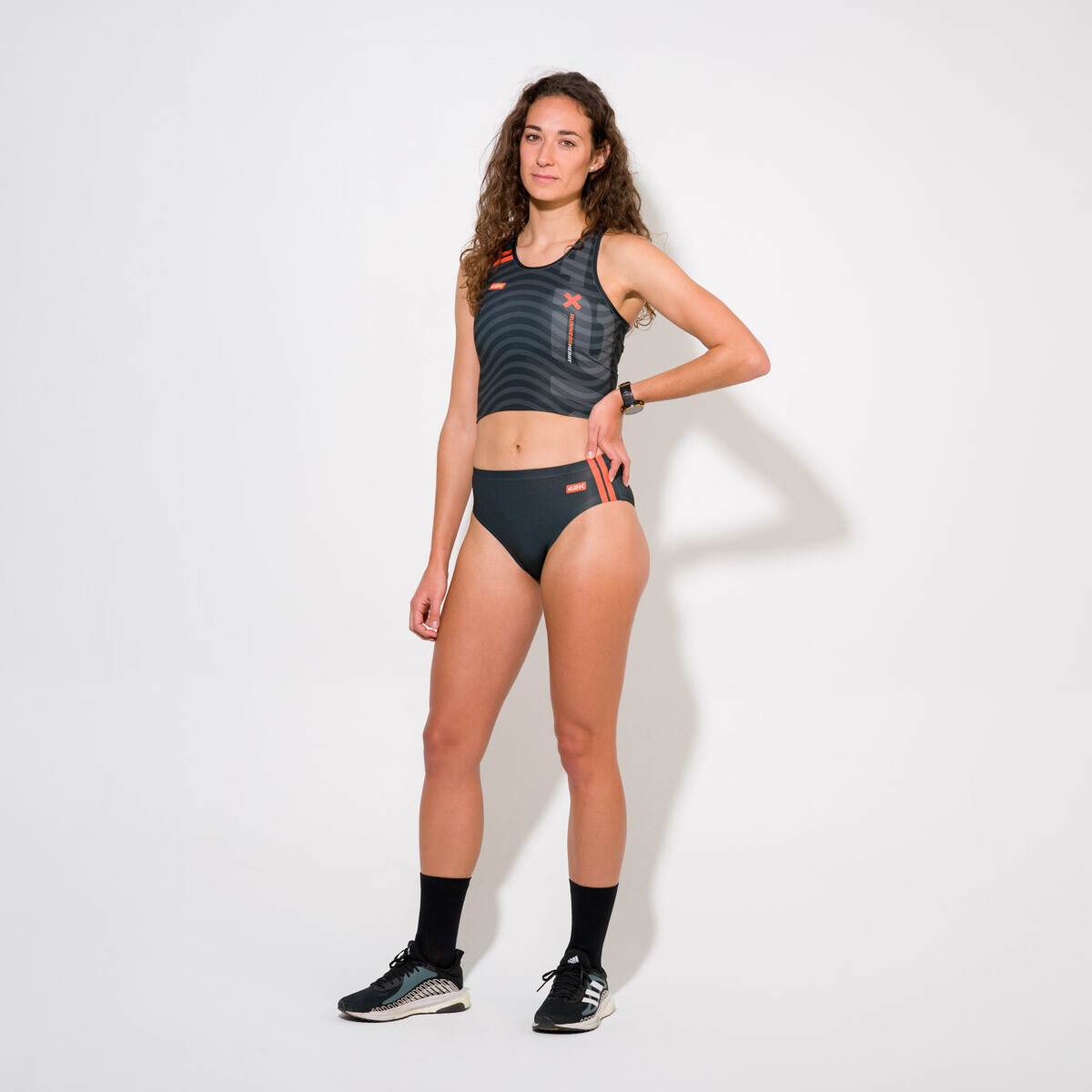
Also offered unisex garments very useful and versatile technical multisport sweatshirt y tracksuit pants. If you want to know in detail, visit the section unisex patterned garments.
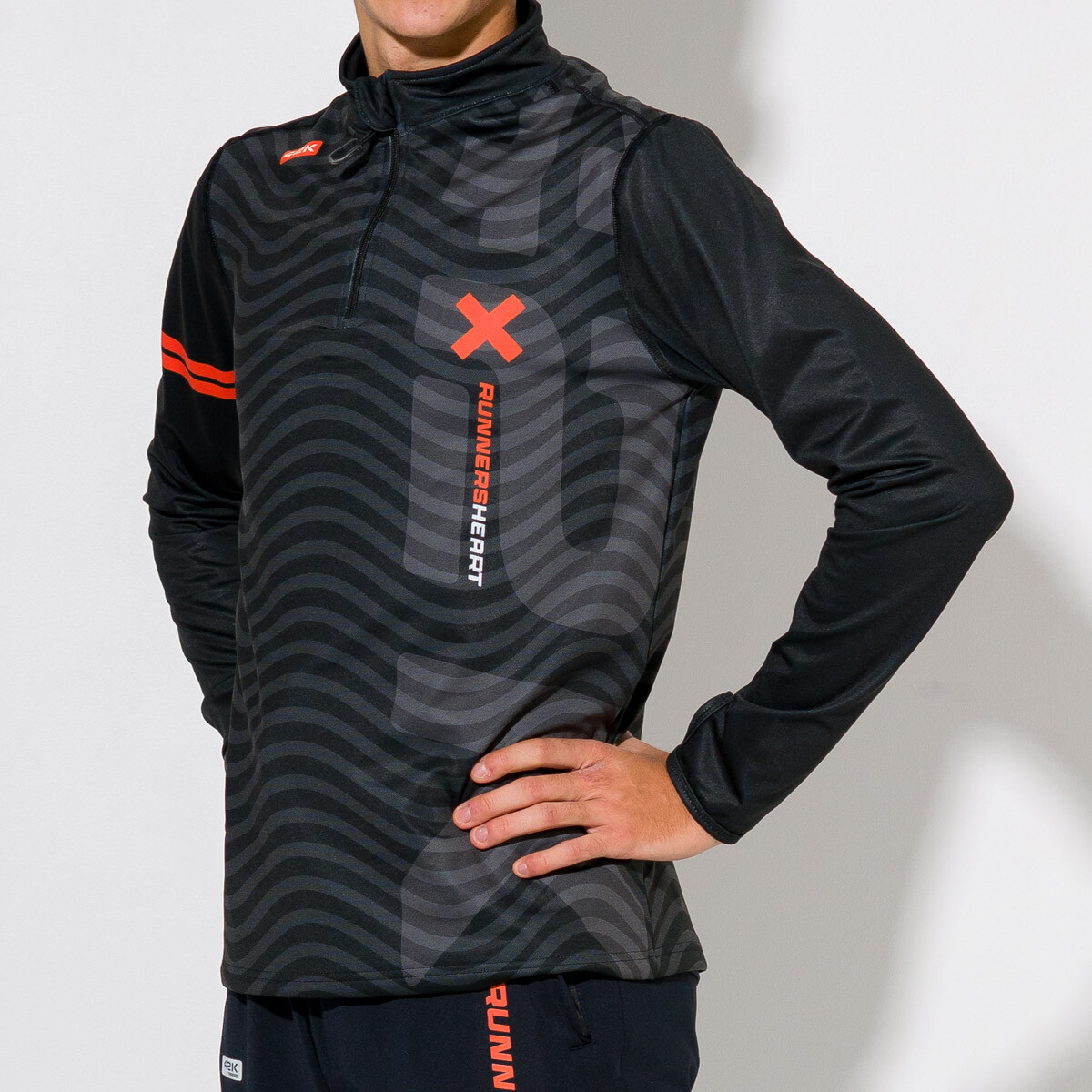

In order to meet the demands and needs of sports clubs that have children's categories in most of the technical garments that make up the catalog of personalized sportswear 42K there is wide range of sizes. The manufacturing possibilities that we offer include sizes ranging from 4 years to XXL in the case of men and XL in the case of women.
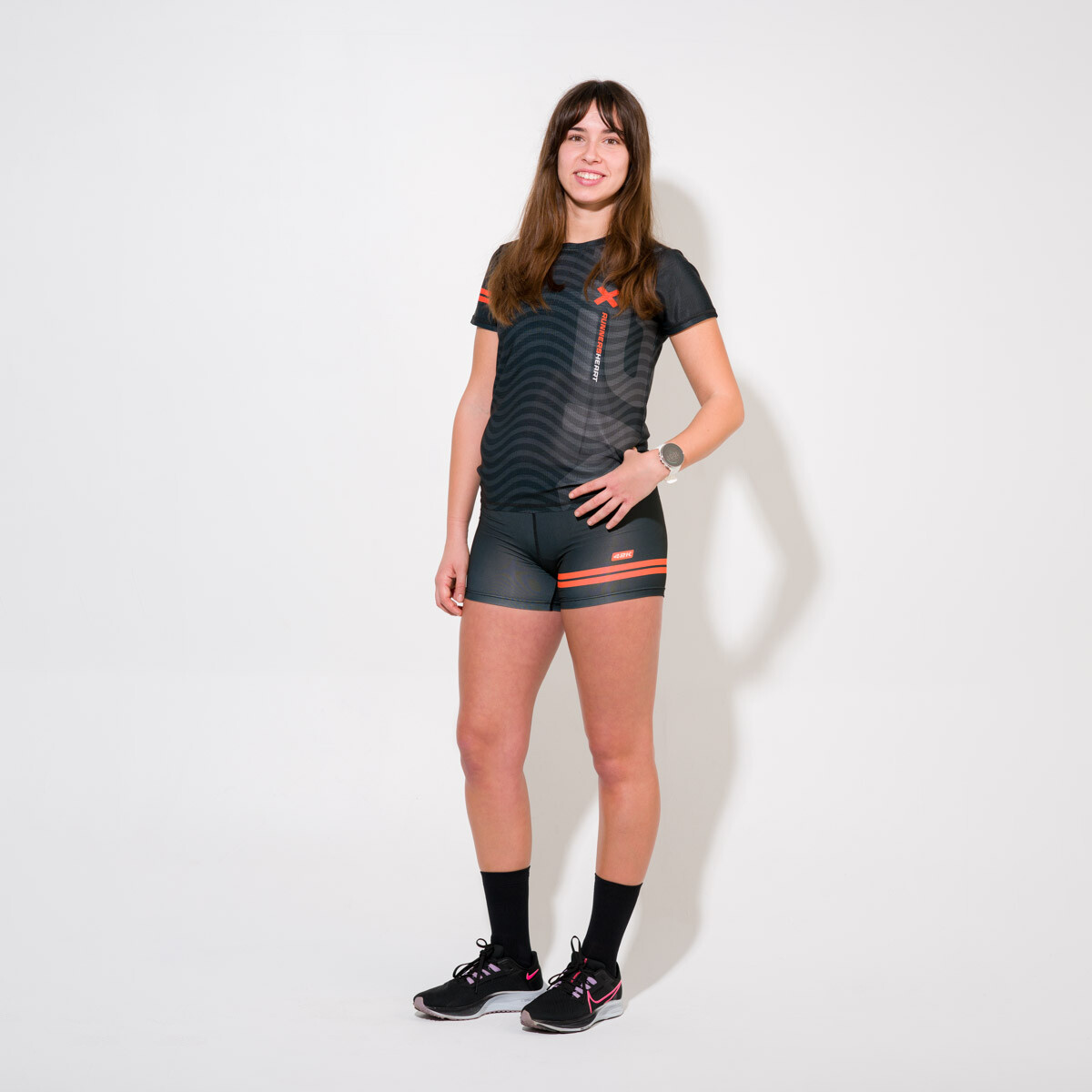
If you have any questions about the different technical garments that we have, you can use the form found on our website and our department CUSTOM will inform you in detail.
Textile sublimation and post-printing clothing, innovation for the realization of personalized sportswear
La textile sublimation is an innovative technique of digital printing on fabric. This technique, which makes it possible to make 100% personalized technical garments without color restrictions, guarantees the permanence of the design (logos, colors, gradients, shields...) since the colors are chemically fused with the fabric.
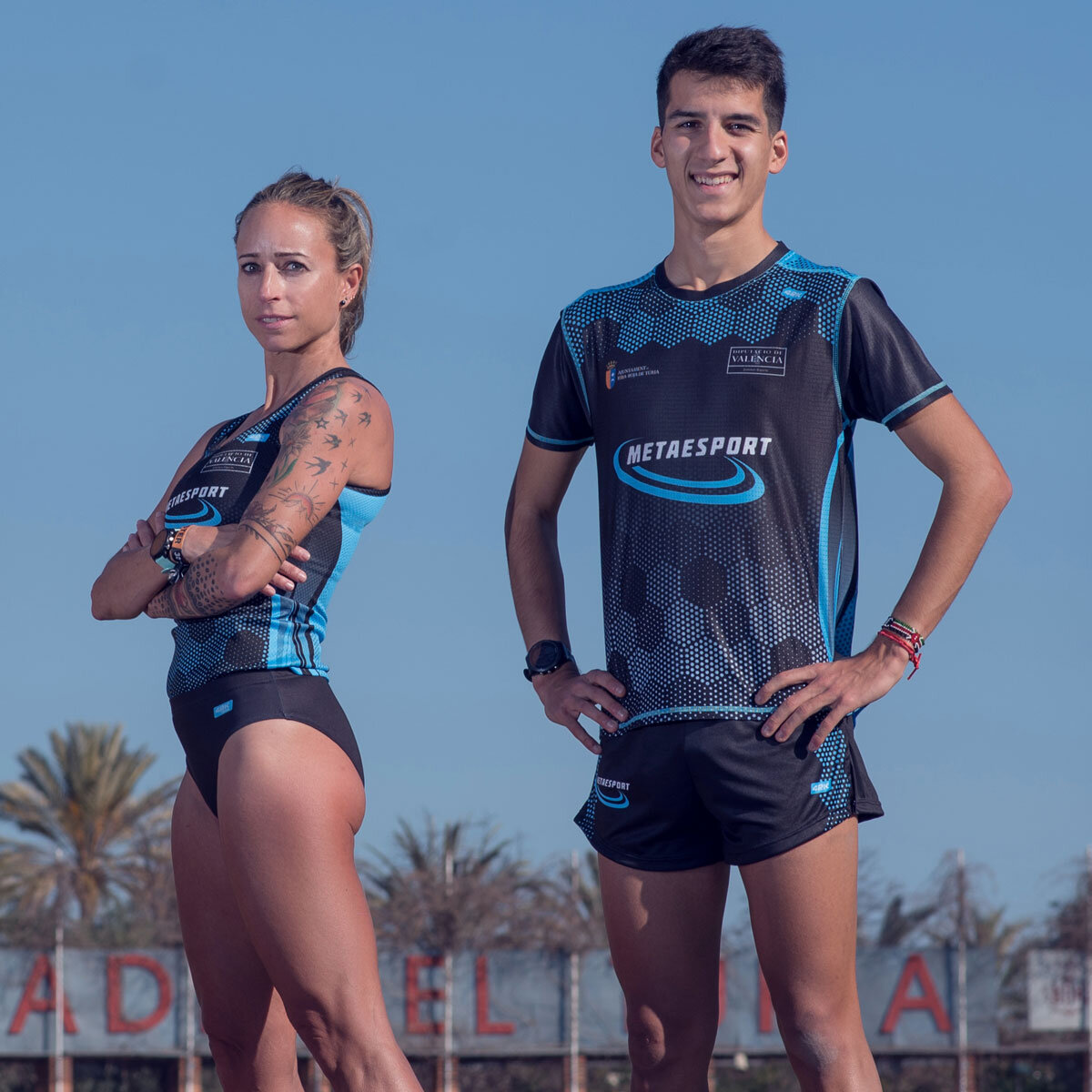
Once transferred, the image or design made by computer is integrated into the fabric and is absolutely imperceptible to the touch. And in addition to leaving no residue, does not increase the weight of the fabric y does not alter its breathability. In this way, any technical garment customized by sublimation preserves all the characteristics of softness, lightness and breathability of the fabric.
Another advantage of sublimation for making personalized sportswear is that allows the entire surface of the garment to be used (with other techniques, customization areas are restricted to the chest and back), including sides, sleeves, neck, etc. And as we have already underlined: no color restrictions.
The line CUSTOM 42K offers three customization options for technical garments
There are three different customization options within the line CUSTOM 42K.
- 1 Option: Templates pre-designed by 42K on which the logos, brands or shields sent by the client can be integrated. The colors of these templates can be adapted to the corporate image of each club, team or collective, but the design is unalterable.

- 2 Option: Exclusive design by 42K. The design team 42K, after the corresponding briefing with the client, proposes an exclusive and original design of 100% personalized sportswear.

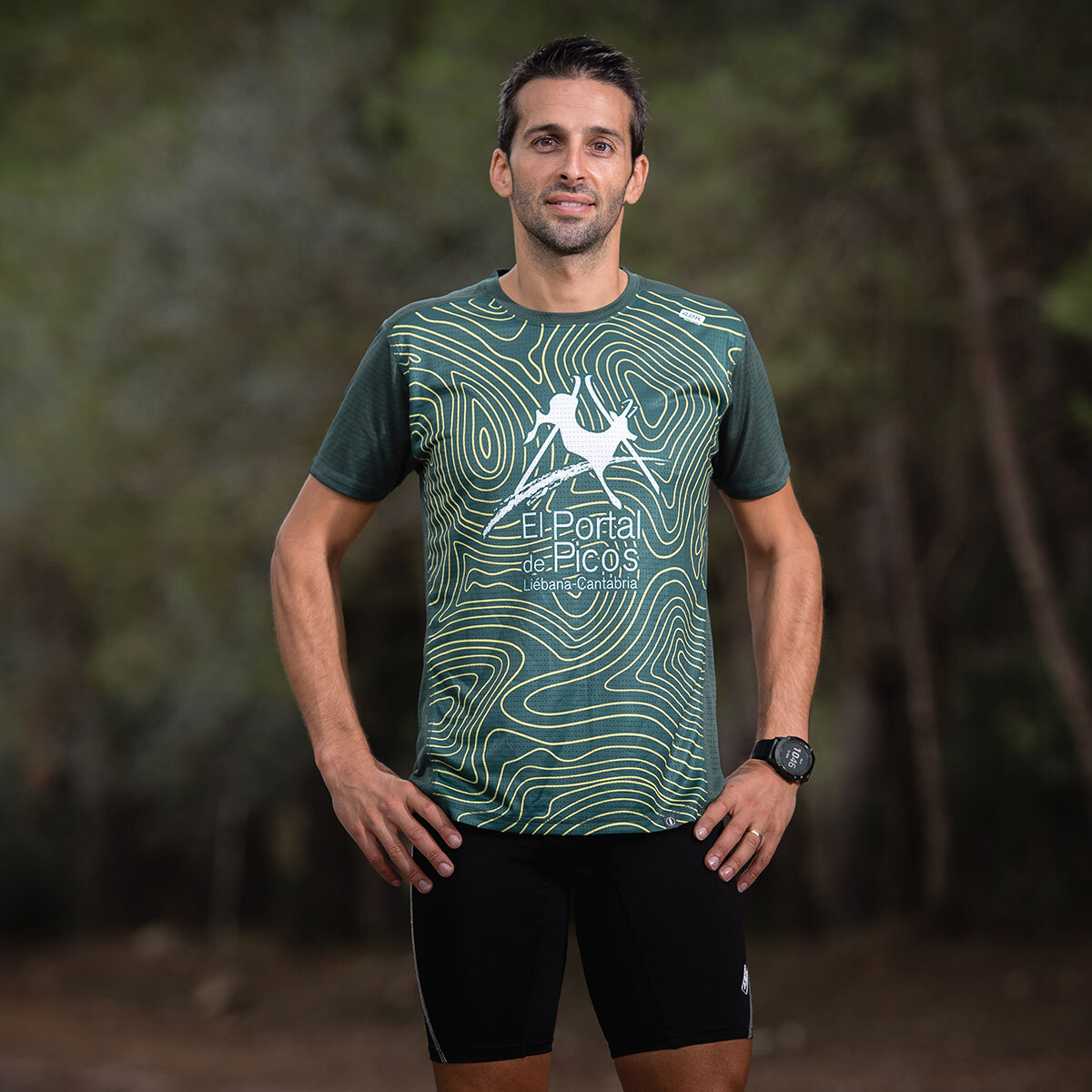
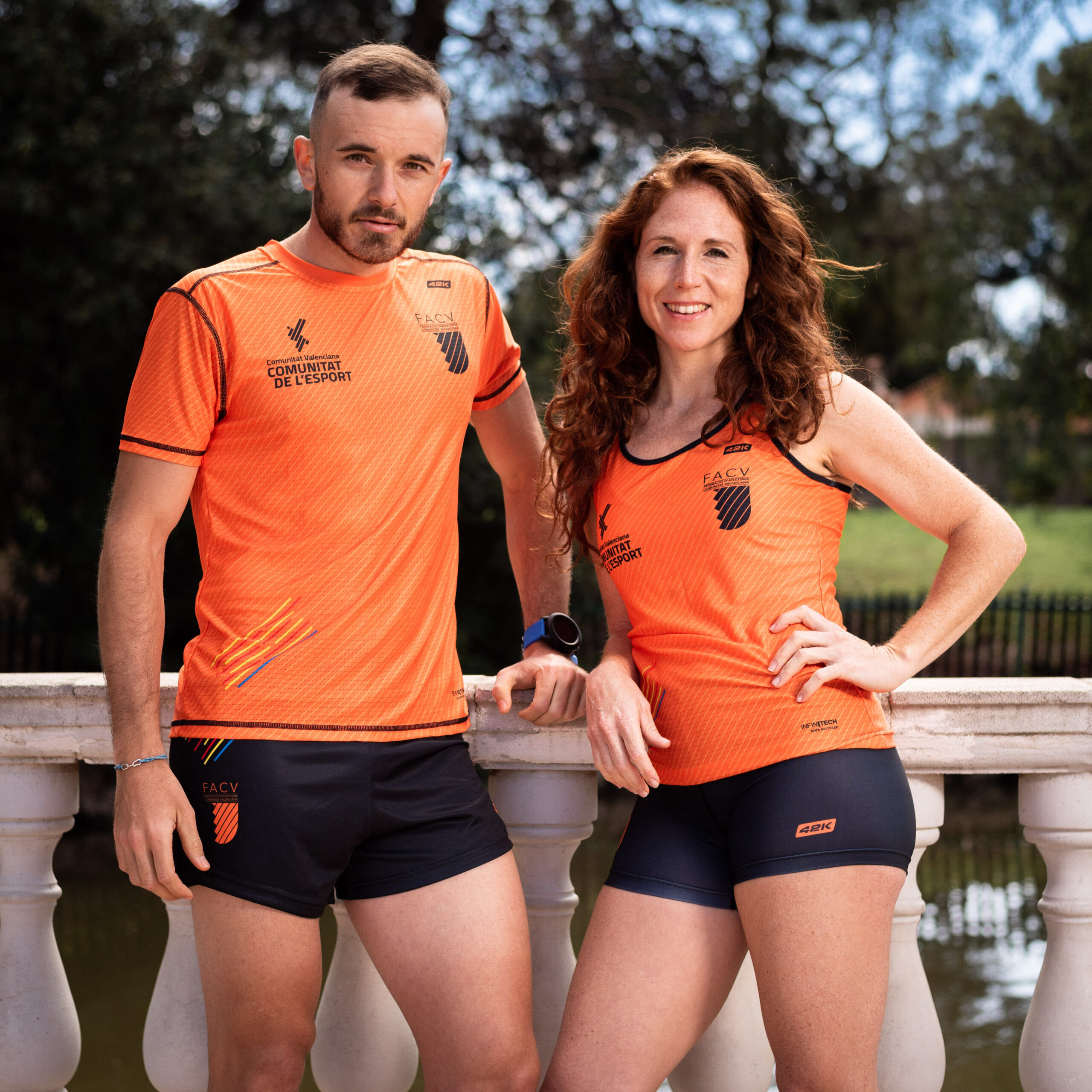
- 3 Option: Exclusive design by the client. The design team 42K It provides the client with the blank digital patterns of the technical garments so that the client can make the desired design.

What advantages does the line offer? CUSTOM 42K of custom sportswear?
There are many advantages that the line CUSTOM 42K offers to guarantee clubs, teams and groups the best option of personalized sportswear of the highest quality, but below we detail the most important ones:
- Wide catalog of technical garments for men, women and kids.
- Endless customization possibilities: from pre-designed templates to exclusive designs.
- 100% customizable technical garments thanks to the digital sublimation y post-print manufacturing.
- Digital sublimation guarantees breathability and does not increase the weight of the garment.
- Different premium technical fabrics, among which a 100% recycled fabric made with polyester yarn obtained from recycling used PET plastic bottles stands out.
- 360º experience. Our Design team together with the Commercial department offer advice and support in the process of making the garments.
- Delivery time: 30-35 days from the confirmation of the design and payment.
- Minimum order from 10 units by model.
Recommendations to keep personalized sportswear in good condition 42K
Personalized sportswear, like the rest of technical garments 42K, requires some special care to extend its useful life. In our blog you can find an article titled How to wash sports clothes to make them last longer in which we offer you a series of tips on how to wash sportswear to prevent it from losing its technical characteristics of breathability, softness or color vibrancy.
Following the advice that we offer you in this article will allow you to keep your personalized sportswear in good condition and that it does not deteriorate sooner than is desirable, especially if you use it regularly. if you follow these care and cleaning recommendations, you will extend its useful life and reduce the risk of annoying or unpleasant odors appearing.
However, if unpleasant odors appear in your personalized sportswear, we offer you 3 tricks to eliminate the bad smell in sportswear that can help you to get rid of the bad smell that sometimes appears in the technical garments with which we run or go to the gym.
La Plantar fasciitis is one of Most common injuries among popular runners and in some cases, if not given the proper treatment and on time, it can become a terrible nightmare of several months of aches, pains and inability to run.
Although the annoying plantar fasciitis affects 10% of the population, It is more common in profiles such as the popular runner, so we are going to see some tips for runners who want to recover from plantar fasciitis.
To answer the question of whether trigger points o "tigger points" can trigger the Plantar fasciitis, It is essential to define each of these concepts in such a way that the possible causal relationship between them can be understood.
The two sports specialties in which it occurs the most are long-distance runners and basketball players. However, it can occur in people who do not play sports regularly, although in these cases it usually appears after 45 years of age.
What is plantar fasciitis and trigger points?
In the anatomy of the foot, the "plantar fascia" or arcuate ligament It is a band of connective tissue that joins the heel with the toes, that is, a thick ligament that stretches when you take a step. Consequently, if a tear or a contraction is caused in the attached muscles, pain appears (plantar fasciitis).
Normally, it hurts in the heel as injuries occur more frequently in this area, but the pain can appear in the middle and anterior part of the sole of the foot. The causes of this injury are diverse, including excessive physical activity, retraction of the Achilles tendon, arthritis and diabetes, and even wearing defective footwear. But, then, what relationship does it have with trigger points?

Is named trigger point to a very specific area or a group of fibers that contracts within the muscle tissue, forming a type of nodule that causes pain when it is active. People who suffer from them often refer to them as "balls", "contractures" or "knots" because they can notice, when they put pressure on them, a kind of swelling.
A characteristic of these nodules is that can be highly irritable And be source of pain in the area where they are or radiate the pain to other areas of the body. They are produced by excessive muscle contraction, stress or inadequate calcium metabolism.
Well, by linking both concepts you can intuit what happens in this case. One or more trigger points located in the gastrocnemius muscles (external and internal) can project the pain towards the heel, as occurs on many occasions. Trigger points do not follow neurological or visceral patterns, which is why, on occasions, it is difficult to locate them and the amount of pain depends on the degree of irritability of the same.
Plantar fasciitis, a common injury in athletes
Plantar fasciitis occurs due to the tendon fascial tissue overload that holds the foot and that is located on the sole. Athletes who make a continuous effort and highly repetitive movements with their feet, such as athletes or soccer players or basketball players, are usually one of the most affected by this ailment.
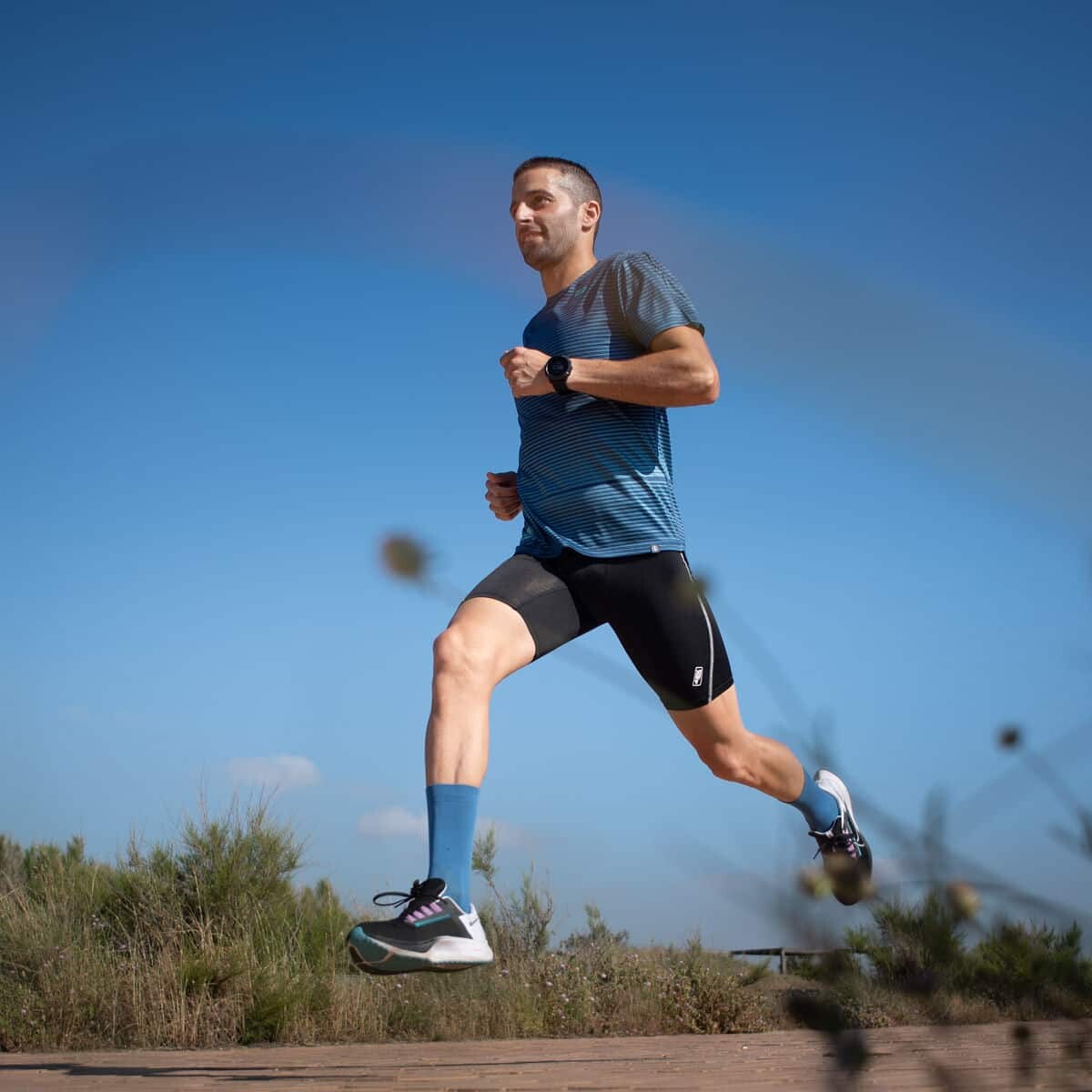
How does plantar fasciitis occur?
The function of the plantar fascia is to provide stability and shock absorption capacity to the longitudinal arch of the foot. The inflammation of the membrane or aponeurosis that covers the muscles of the sole of the foot and its insertional area in the heel, caused by the tractions in each impact and in the propulsion movements of the foot, is what is called in sports medicine, plantar fasciitis.
The high-performance activity to which professional athletes subject their heels, especially when running on hard ground or surfaces, cause continuous percussion on the soles of the feet, which produce micro-traumatisms, which in turn are responsible for a possible inflammation of the heel and its consequent generation of pain.
In some cases, chronic heel pain can also be caused by a so-called calcaneal spur (spike at the bottom of the heel seen on X-ray), which also causes inflammation around the fascial fibers, although it has no cause. why be the cause of plantar fasciitis. Between 15 and 25% of the population have a heel spur but do not experience pain and, in contrast, many runners with plantar fasciitis do not.
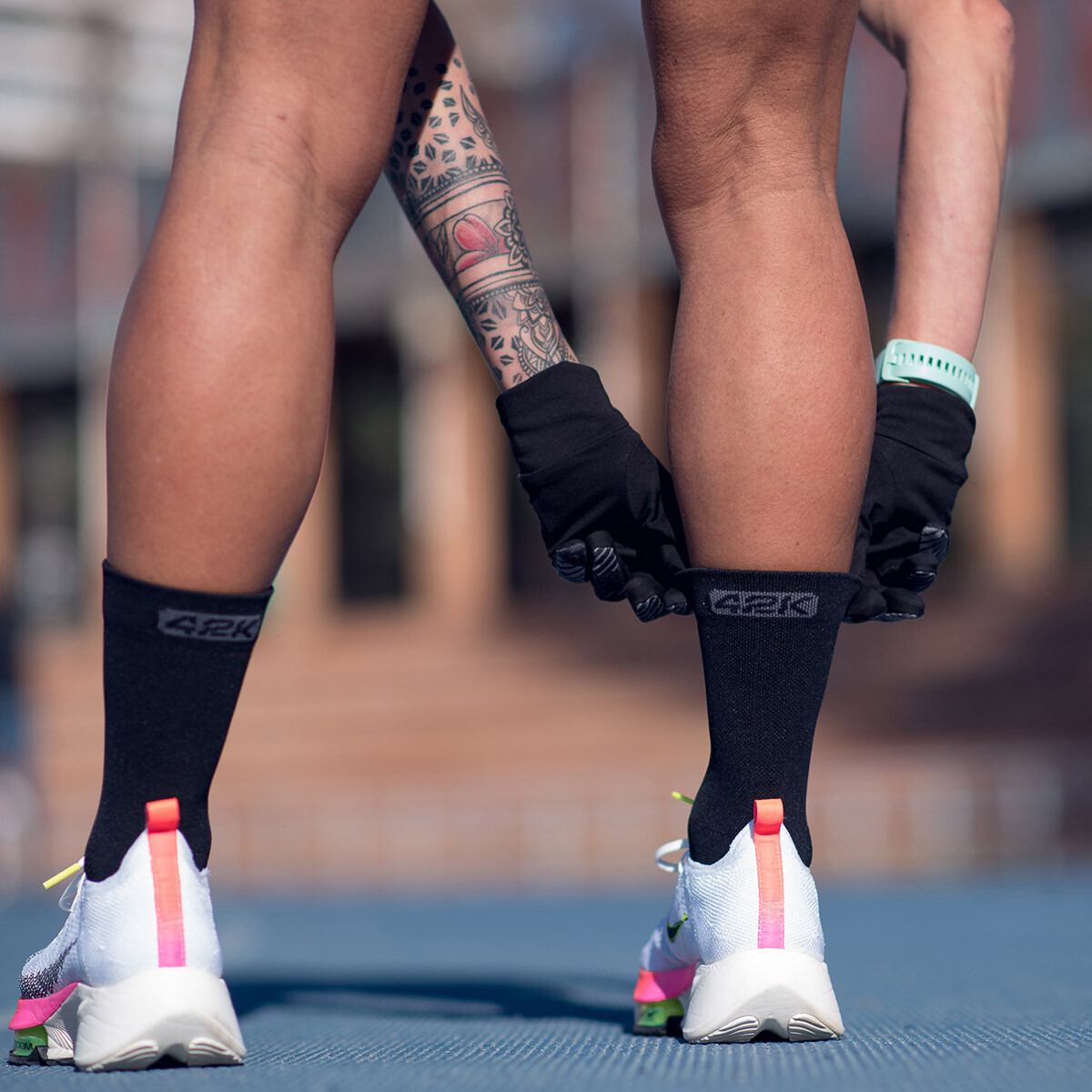
The main causes of this injury are:
- Overload: It is usually the most common and is caused by the excessive use of the joint or the repetition of a sports technique developed in an erroneous way.
- Change of footwear: It is very common for plantar fascia pain to appear when renewing sports shoes.
- Bone problem: Some bone-type malformation can generate plantar fasciitis.
Main symptoms of plantar fasciitis
When you suffer from plantar fasciitis the main symptoms are the following:
- Pain: It is what the patient suffers the most and the first thing he notices when doing any sporting activity.
- Tenderness and swelling
- Heat
- Redness
- Tension in the sole of the foot
Prevention
Prevention of plantar fasciitis is relatively simple: the warming up and el stretching prior to physical exercise is essential to avoid it. Before each training session, a light run of 5 or 10 minutes is recommended. Afterwards, it is necessary to carry out, in addition to the general stretching, some specific ones on the sole of the foot to reduce the probability of injuries to the fascia of the foot and the muscle-tendon structures.
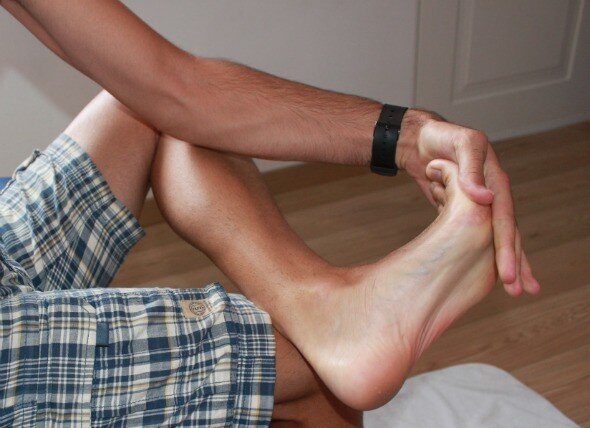
La choosing the right shoe it is essential. The shoe must be comfortable, with an appropriate size for the foot, since the feet may not be symmetrical. The athlete must try each new pair of shoes even if they are the same model that he usually uses.
How to treat plantar fasciitis?
El treatment of tigger points or trigger points It is based on physiotherapy with the performance of pressure massages on these nodes. The most widely used techniques that produce significant improvements are decontracting mesotherapy, cryotherapy, the dry needling technique, stretching prescribed by the physiotherapist and post-isometric relaxation.
In short, when there is pain in the sole of the foot and there has been no injury or any of the usual causes have been ruled out, it is necessary to guide the examination towards the detection of trigger points as a possible cause of the pain. plantar fasciitis
Once the diagnosis has been made, usually through a physical examination and the description of the symptoms reported by the patient, the sports doctor will decide which is the action protocol to be carried out. Only exceptionally is surgery used to treat this type of injury.
Although, there is no evidence of the effectiveness of a specific treatment for plantar fasciitis, there is a series of recommendations that in many cases can lead to its cure. Among them is the correction of training errors.
To heal quickly and without relapses, the injury must be identified as soon as possible and begin to avoid the painful gesture that causes it, since once it is established, it can take 8 to 18 months for the definitive healing.
Plantar Fasciitis Treatments
- In the acute phase of pain, use ice, and will apply Massage of about the zone of 10 or 20 seconds, 3 or 4 times a day. This prevents inflammation. Repeated use of ice or cryotherapy is the most effective treatment as cold limits pain, swelling, bruising and inflammation.
- The ultrasound continuous (5-10 W/cm) for about 5 minutes a day, they will be used in the post-acute phase of the injury, at 48 hours. The effects of ultrasound (pain reduction, increased blood flow, increased metabolism and reduced muscle spasm) help in the treatment of the injury, and give good results in athletes.
- Un deep massage, in small circular movements on the affected region, will reabsorb the edema and reduce muscle spasm.
- Combining ultrasound with electrical stimulation it can also be effective. Ultrasound acts on deep tissues and muscle stimulation increases the flexibility of the sole of the foot.
- The extracorporeal shock waves can help runners and athletes with plantar pain of more than a year of evolution, with chronic pain in the heel area. Some doctors recommend it, but its effectiveness is still under study.
- El tapping (bandage with adhesive tape strips) can help relieve pain. Such a bandage will limit the stress on the plantar fascia. It is also useful in case of a rupture of the aponeurosis.
- When acute pain is experienced, you can use templates shock absorption, discharge insoles, personalized insoles with previous biomechanical studies to correct the varus-valgus of the foot.
Tips for Coping with Plantar Fasciitis
If you suffer from plantar fasciitis, the first thing is to rest. It's never easy, especially if you have to walk a lot because of your work, but the ideal is to reduce the number of days of running, or even eliminate the series for swimming or cycling. It is also advisable to put a bottle of frozen water under the sole of the foot and roll it little by little for 8 or 10 minutes two or three times a day.
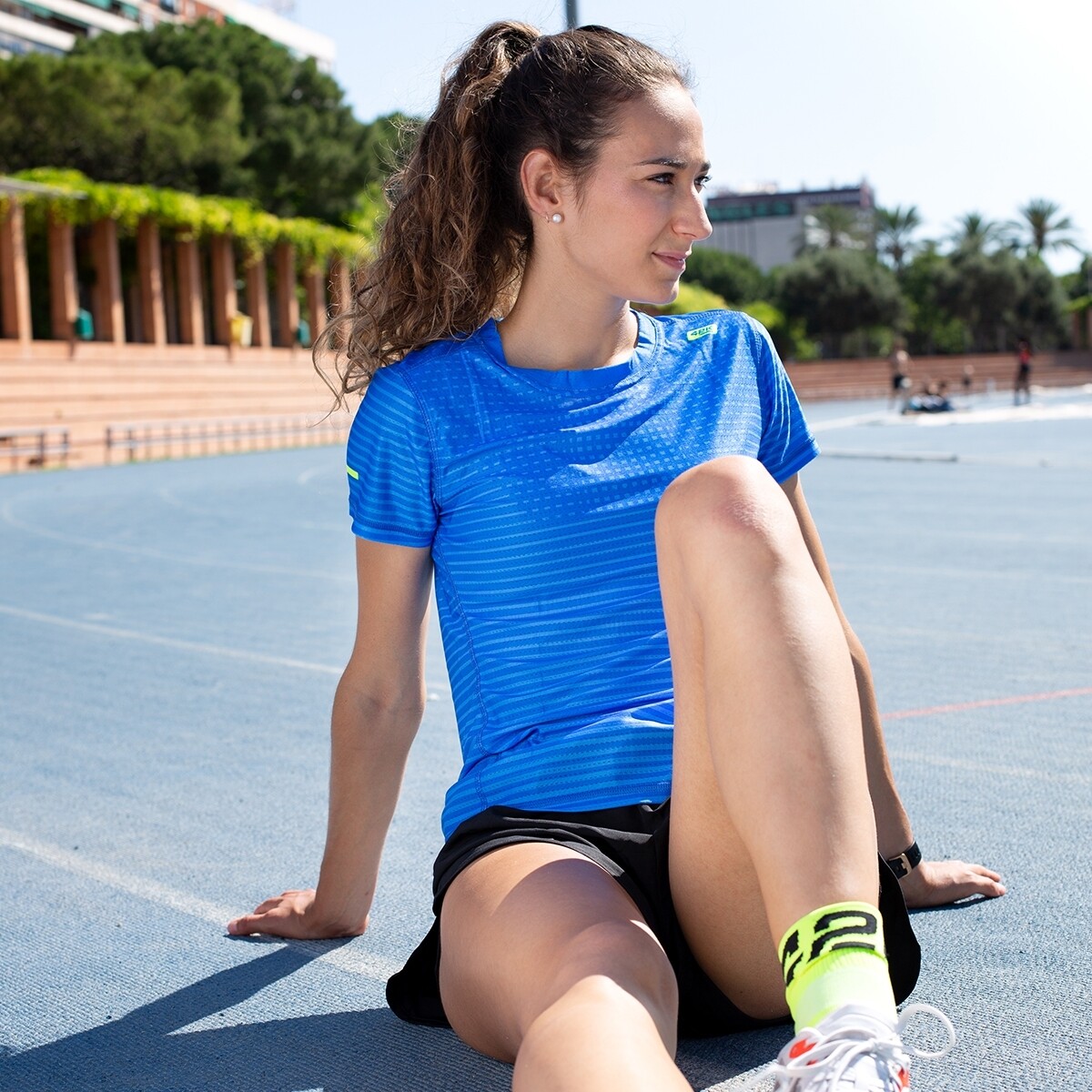
We must also pay attention to footwear (and not only the one we use for sports, but also the one we use in our daily lives), an aspect that we don't always give the importance it deserves and that can be behind sports injuries such as plantar fasciitis. Whether for running or for day-to-day use, wear shoes with good cushioning, which are comfortable and support the arch of the foot.
Be careful with flip flops or flip flops
Be careful with flat or worn shoes and sneakers; likewise, have be careful with the use of flip-flops or flip-flops because it is a type of footwear that can cause many problems if it is not used correctly.
In this article of partners They explain very clearly the risks of misusing flip flops or flip flops.
Don't forget the stretches, both of the foot muscles and the heel. You can actually do exercises to strengthen those muscles, for example picking up marbles with your foot and putting them into a cup or towel from the ground with your foot. Stretching with an elastic band and the calf are also interesting.
Finally, it is advisable to go to the specialist to prescribe painkillers such as ibuprofen or even the use of a splint while we sleep. Physiotherapy work is another treatment that will help you recover from plantar fasciitis; Your physio will give you good guidelines to follow to cure it and prevent future problems.
If medical treatment fails, surgery can be performed. Experts only recommend surgery if pain persists after three months of treatment. The foot is one of the key anatomical structures in the athlete. Any discomfort caused by the effort involved in high competition, which affects this area, affects the mechanics and can cause other injuries to the knees, hips, etc.
42K Running uses its tissue cell technology commonly called "honeycomb" for the preparation of its Custom shirts CUSTOM.
CELL TECHNOLOGY
Made with 100% polyester yarn and under our multifunction hexagon design, we create cell technology one of our best fabrics for making technical t-shirts for running, trail or fitness.
Its hexagon design allows us an excellent body perspiration also offering us its advantages Anti-friction and their good behavior before multiple washes of a sports garment.
cell technology It will also offer us optimal wear and tear performance.
Below we detail the technologies applied to said fabric for the practice of running, trail or fitness.
 |
Dry-Tec® technology directly affects the breathability of our garments. This technology is responsible for managing the moisture produced by the body, generating a rapid evacuation to the outside and rapid evaporation. |
 |
The DC4® process is used in our sports garments in order to fix the color and turn it into a garment whose intensity does not deteriorate over time or with washing. 42K Running Bet on current, dynamic and sporty colors, this process guarantees the color of our products for much longer. |
 |
The first characteristic that makes a technical garment an appealing garment is its softness and lightness. This is precisely what the SoftLight® technology is responsible for, a process by which the fibers of the fabric undergo a change where any possibility of abrasion is eliminated and a very soft and comfortable finish is achieved to the touch. |
42K · All rights reserved
